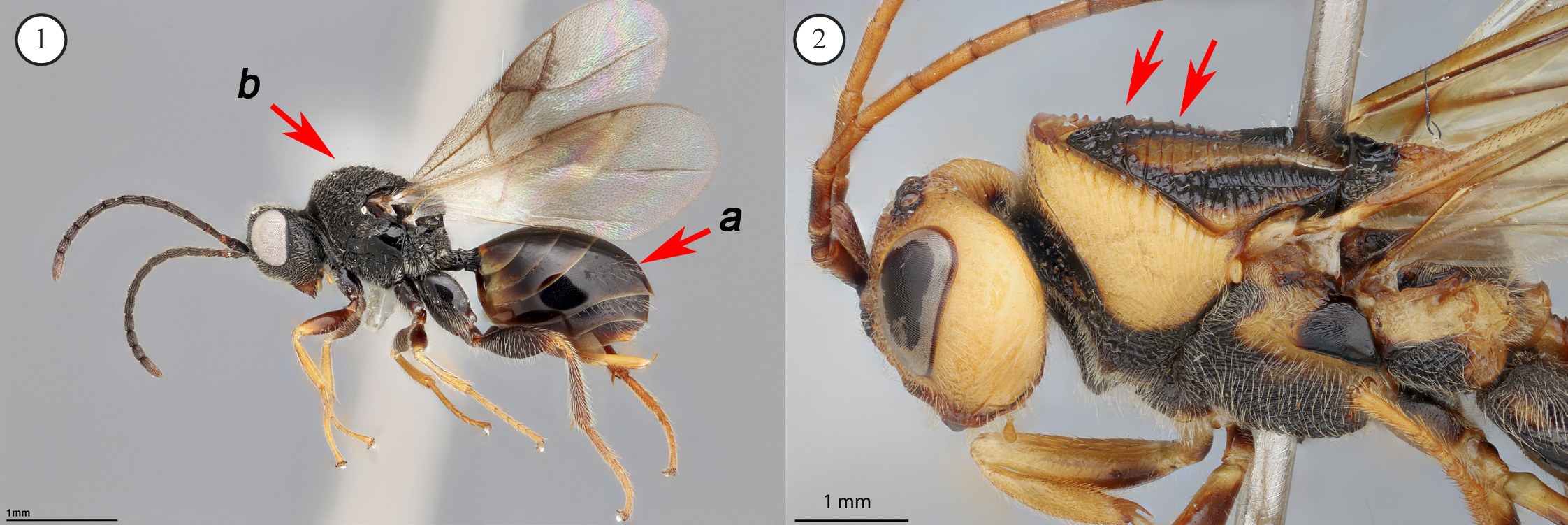
1. Metasomal segment four, five or six the largest (in lateral
view), with two to four small segments preceding largest segment (a, Fig 1).
Wings always fully formed, with marginal cell of forewing sometimes very
elongate. Often large wasps, exceeding 10 mm in length. Mesoscutum with heavy
sculpture (well-developed ridges or pits; b, Fig 1; arrows, Fig. 2) ...2
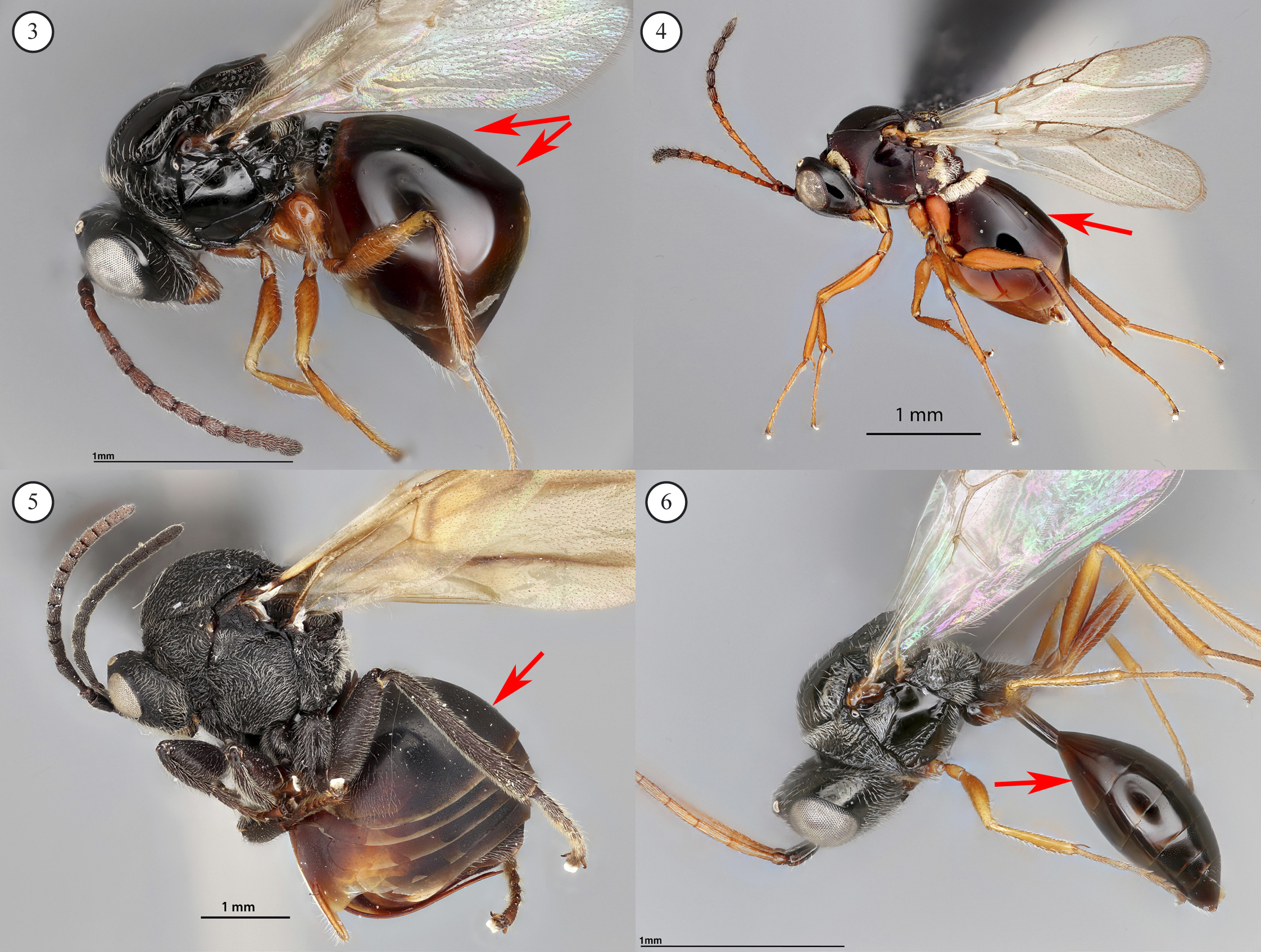
— Metasomal segment two or three the largest (in lateral view),
or fused into a syntergum (arrows, Figs 3 and 4), with at most one or two
segments preceding the largest (arrows, Figs 5 and 6). Wings usually fully
formed; marginal cell of forewing usually shorter, rarely as long as 3x as long
as high. Adult wasps smaller than 10 mm in length. Deep ridges in mesoscutum
less common; typically microcoriaceous or smooth ...3
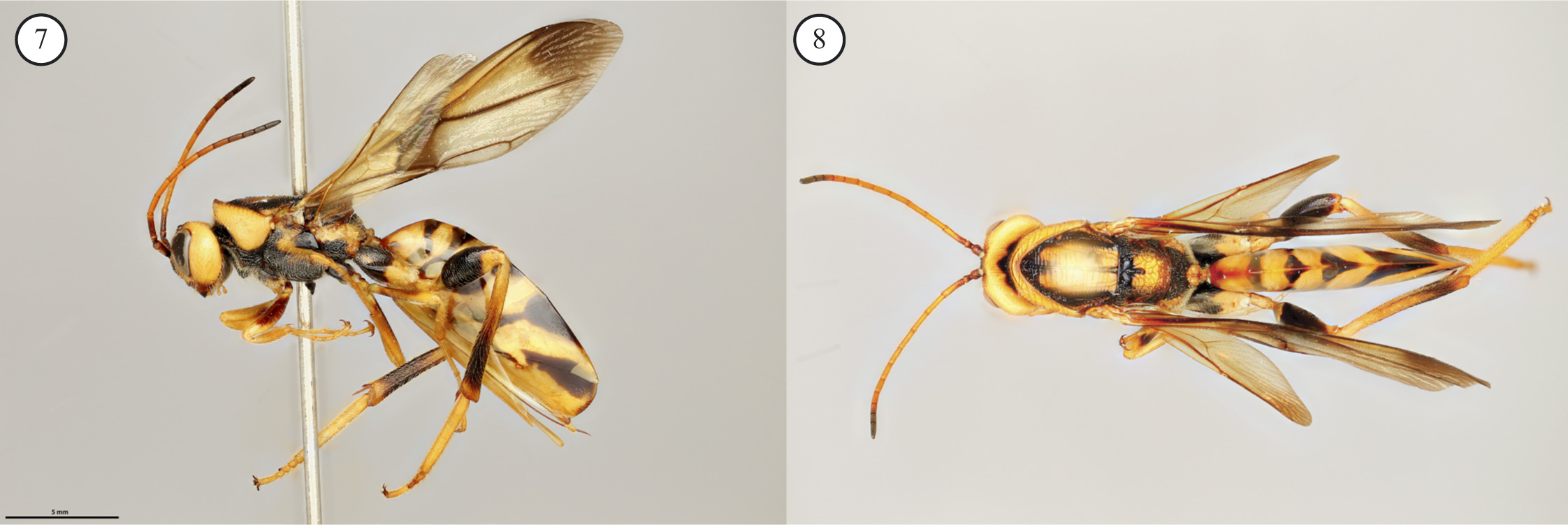
2. Metasoma elongate and very laterally compressed, thin,
blade-like (arrow, Fig. 8). Radial cell of forewing extremely elongate (9x as
long as high) (arrow, Fig. 7). Large, over 20 mm in length ...Ibaliidae
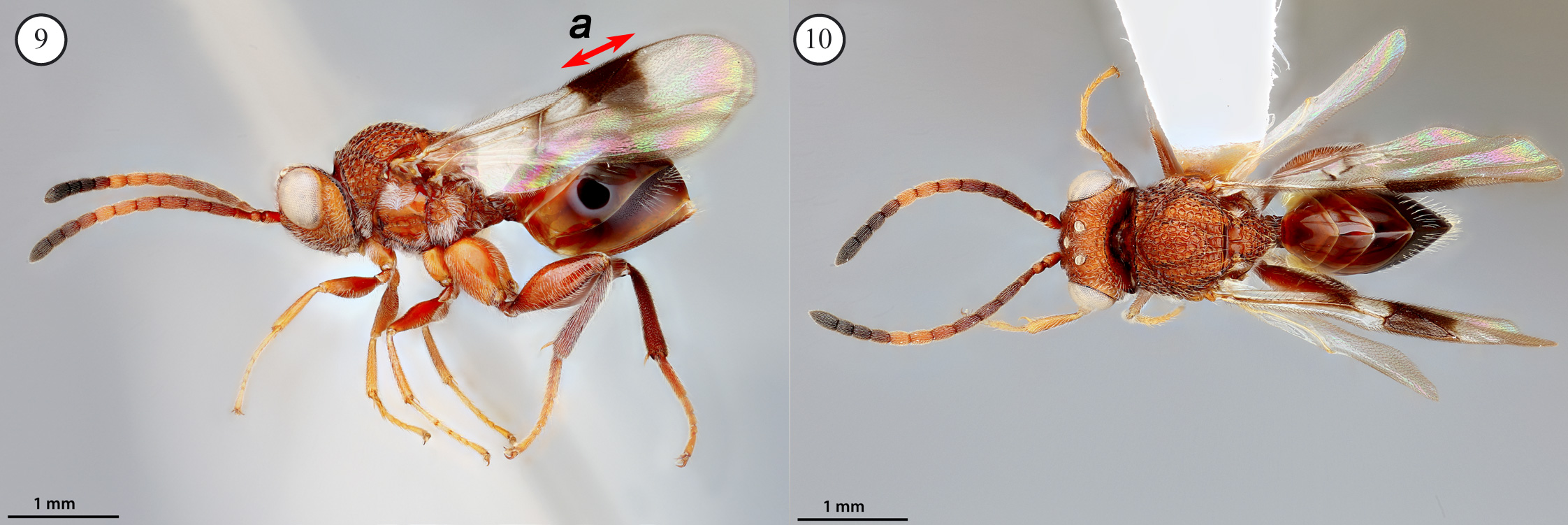
— Metasoma rounded, ovate, subcylindrical (Fig. 10).
Radial cell of forewing moderately elongate (3-4x as long as high) (a, Fig. 9).
Size varying, sometimes small, always under 20 mm. ...Liopteridae
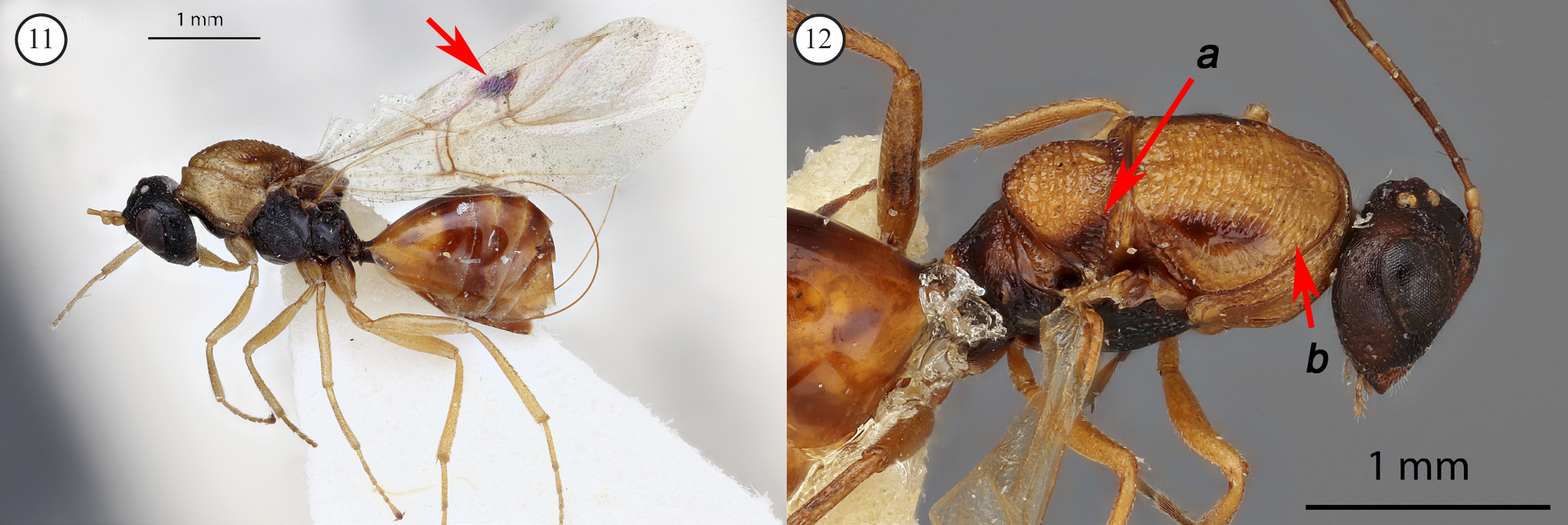
3. With a pterostigma (Fig. 11). No foveae or lateral bars on scutellum (a,
Fig.12). Mesoscutum with well-developed transversal ridges (b, Fig. 12).
Australia only, very rare ...Austrocynipidae
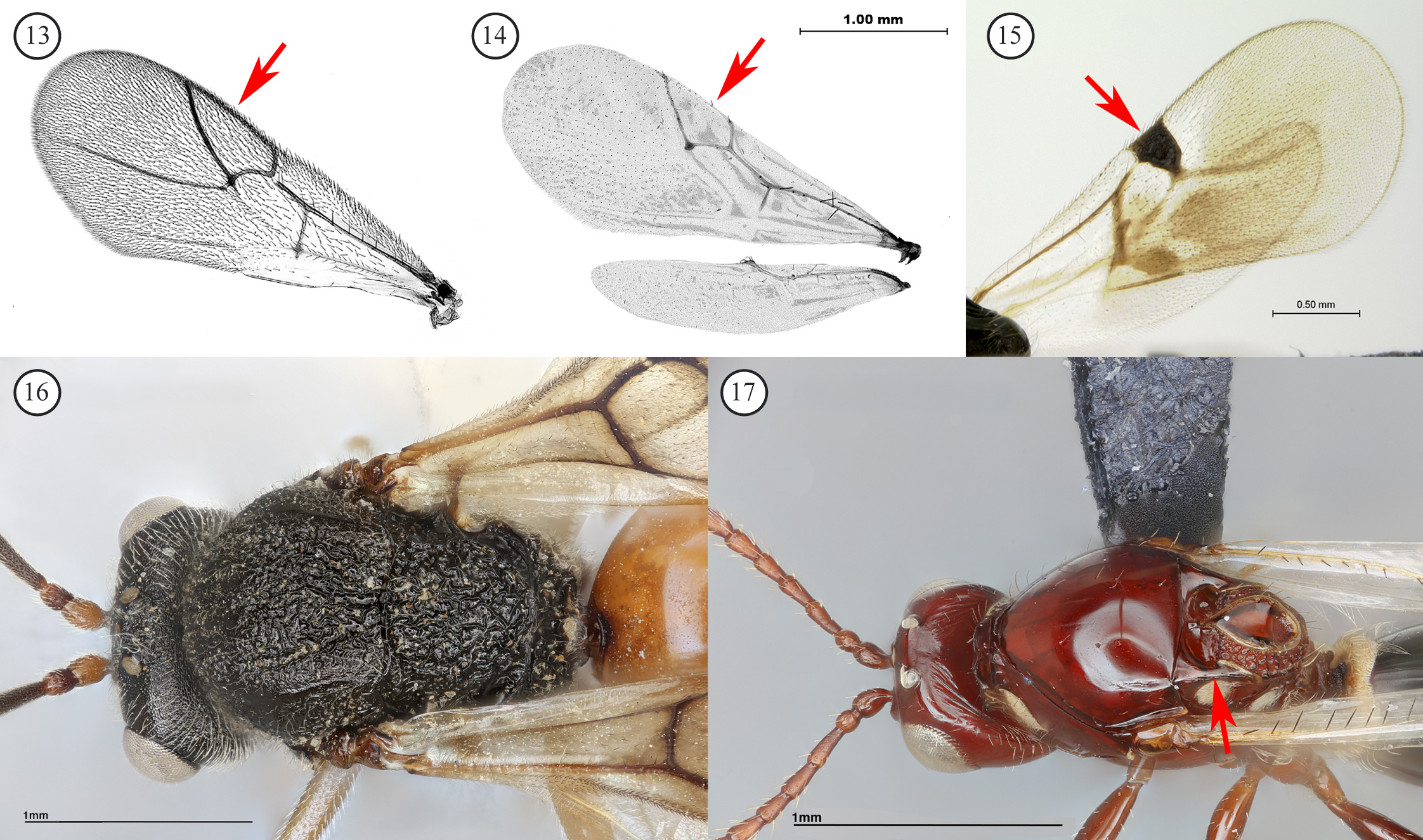
— Without a pterostigma (arrows, Figs 13 and 14) (very rarely the
entire marginal cell is pigmented forming a pseudostigma; arrow, Fig. 15),
rarely brachypterous/apterous. Usually with more or less developed foveae and
lateral bars of scutellum (arrows, Fig. 17). Mesoscutum never with
well-developed transversal ridges (Figs 16 and 17). Worldwide ...4

4. Fully winged (Figs 18-20). Note: brachypterous/wingless forms,
or specimens with obscured, tangled or damaged wings, can be identified via this
route too ...5

— Brachypterous or apterous (Figs 21-23) (shortcut route to
groups where this feature is known) ...33
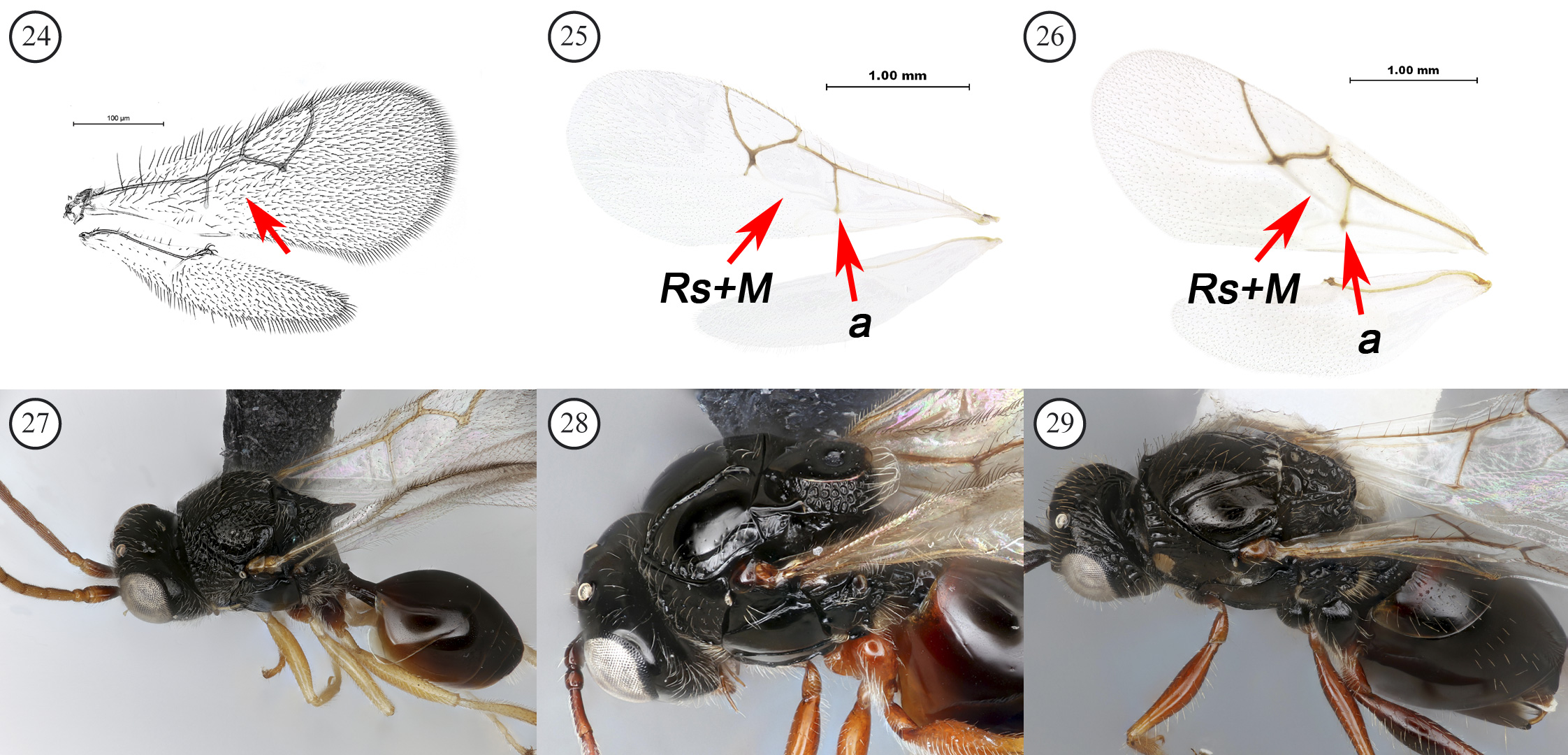
5. Rs+M vein often indistinct or absent (arrow Fig. 24); its
proximal part, when present as a more or less faint vein (Fig. 25) or a fold
(Fig. 26) joins basal vein at ventral end of basal vein (a, Figs 25 and 26). Areolet
usually absent. Usually head and mesosoma shiny (Figs 28 and 29), rarely rugose
or matte (Fig. 27). Scutellum often complex, with differentiated sculpture,
plates, spines etc ...6
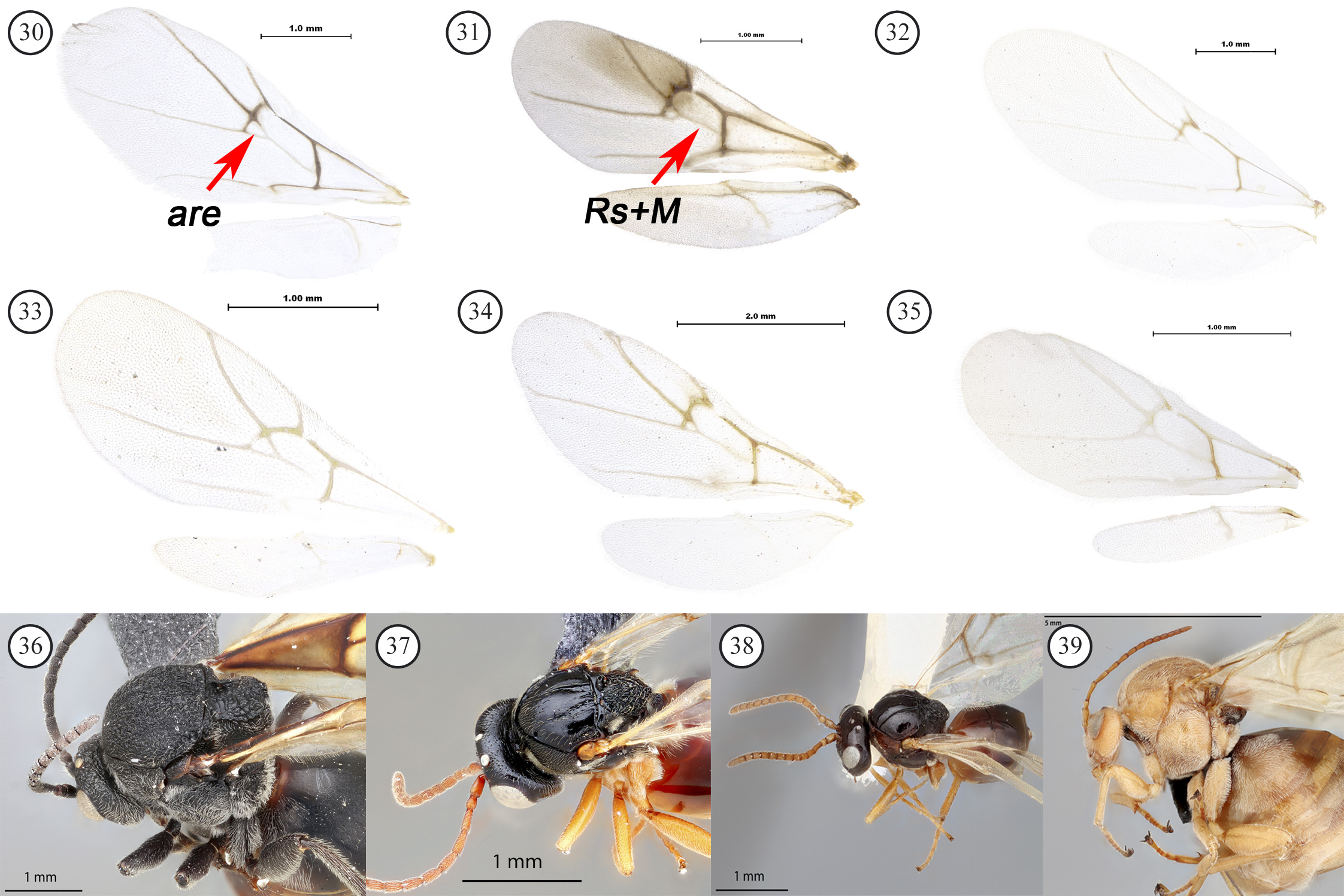
— Rs+M starts at (or points towards) mid-length of basal vein (Rs+M,
Figs 30-35). Aerolet often present (are, Figs 30-35). Usually large parts of
head and mesosoma matte (Figs 36 and 39), rarely smooth/shiny (Figs 37 and 38).
Scutellum relatively simply built (most
Cynipidae)
...8

6. Head, pronotum and mesoscutum shiny, more or less smooth, and
usually not densely hairy (Figs 40-42) (most of
Figitidae)
...19

— Head, pronotum and mesoscutum matte from dense microsculpture,
and more or less densely hairy (Figs 43-45) ...7

7. With dense pubescence on base of metasoma (arrow, Fig. 46);
usually with distinct pronotal plate (arrows, Fig 47); often with complex
sculpture on scutellum (arrow, Fig. 48) (some
Figitidae)
...19

— Usually without dense pubescence on base of metasoma (Fig. 49)
but sometimes with small lateral patch (arrow Fig. 50); usually without distinct
pronotal plate (arrow, Fig. 51); always with a relatively simple scutellum
(arrow, fig 49) (some
Cynipidae) ...8
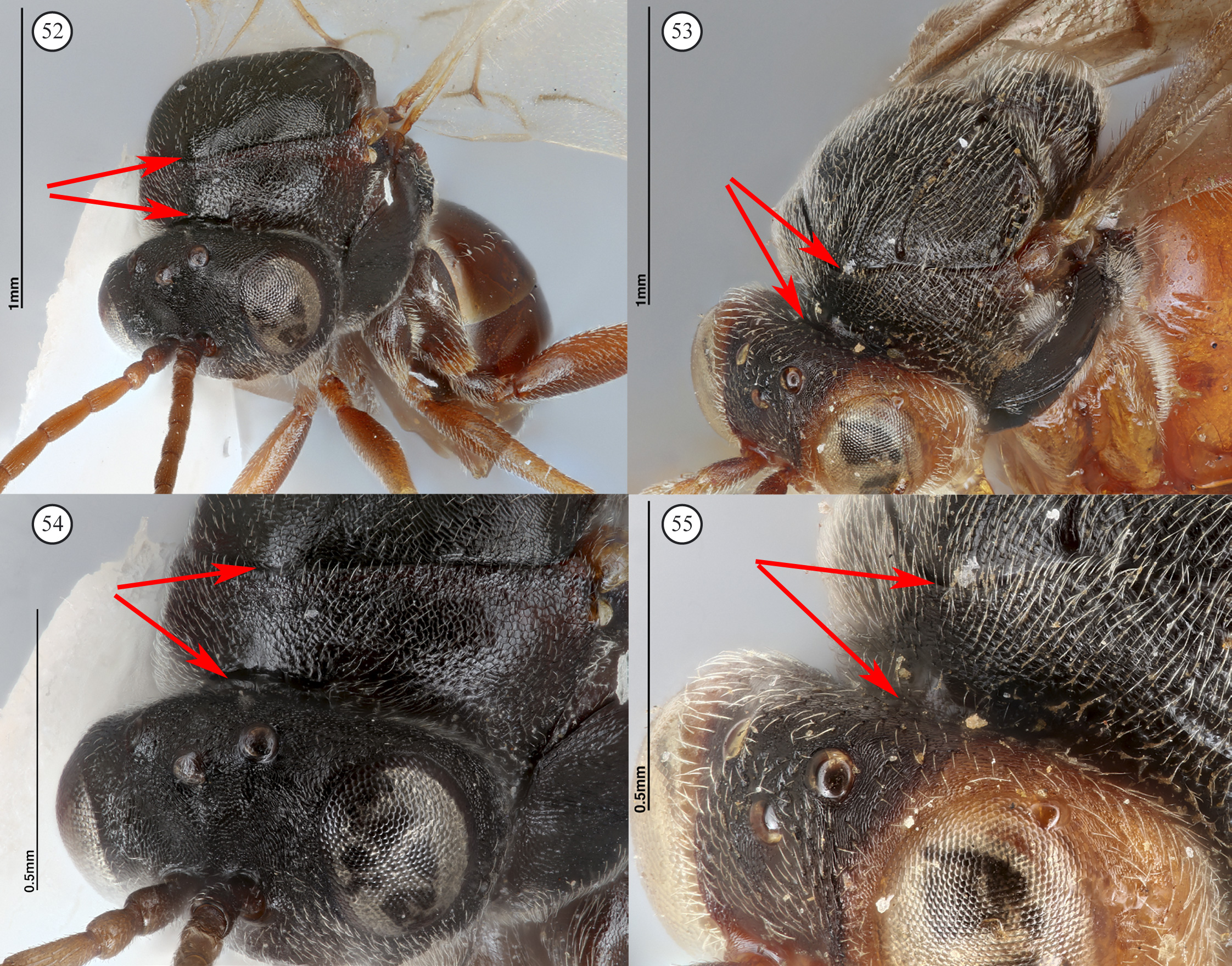
8. Pronotum dorsomedially at least 1/6, usually 1/3, as long as
greatest length of outer lateral margin (arrows, Figs 52-55; with truncation and
pits, sometimes forming a pronotal plate, rarely narrow ...9
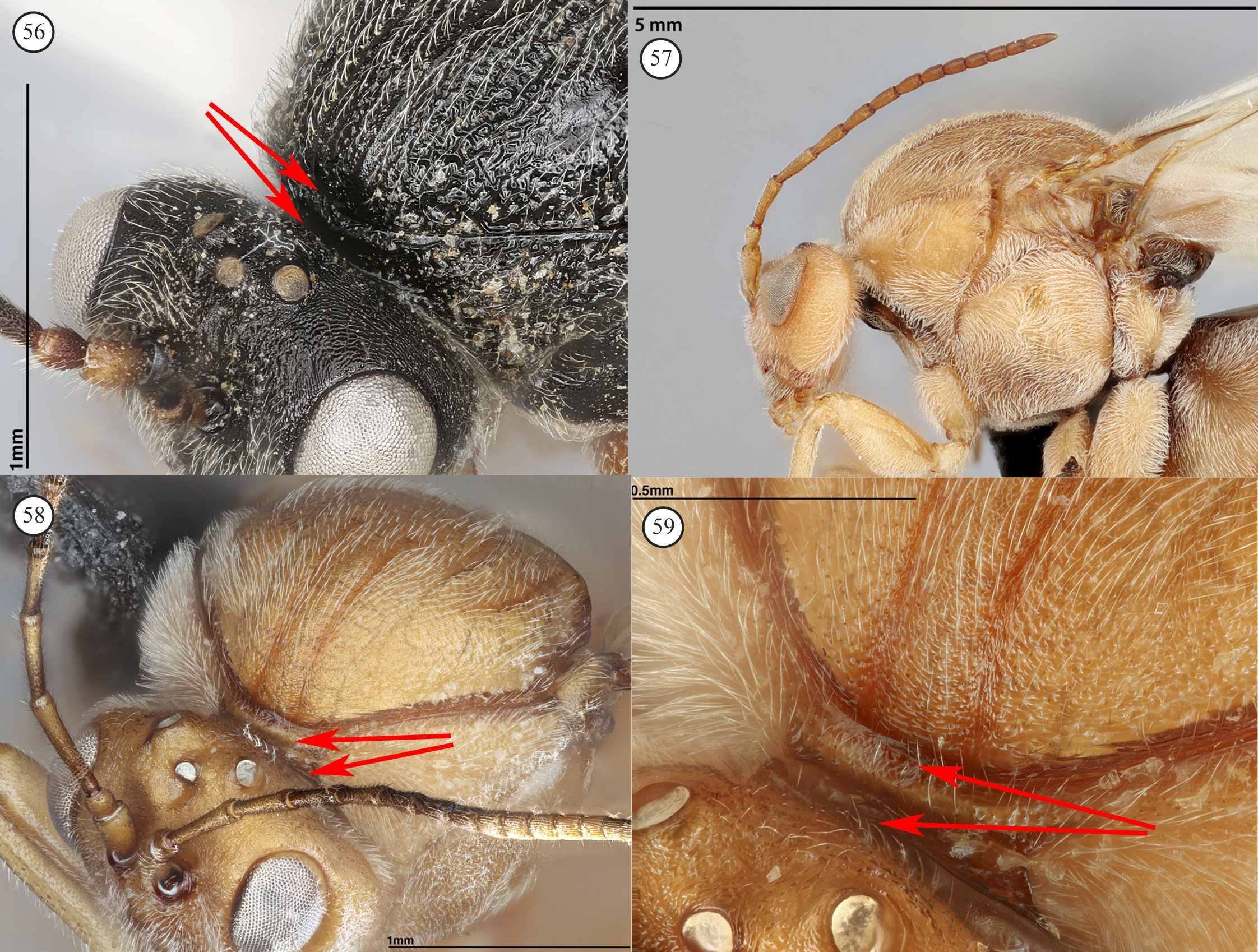
— Pronotum dorsomedially short, 1/7 or less compared to length
of outer lateral margin (arrows, Figs 56-59); truncation or pits absent, or
present only by weak, superficial and continuous depression, pronotal plate
always absent ...17
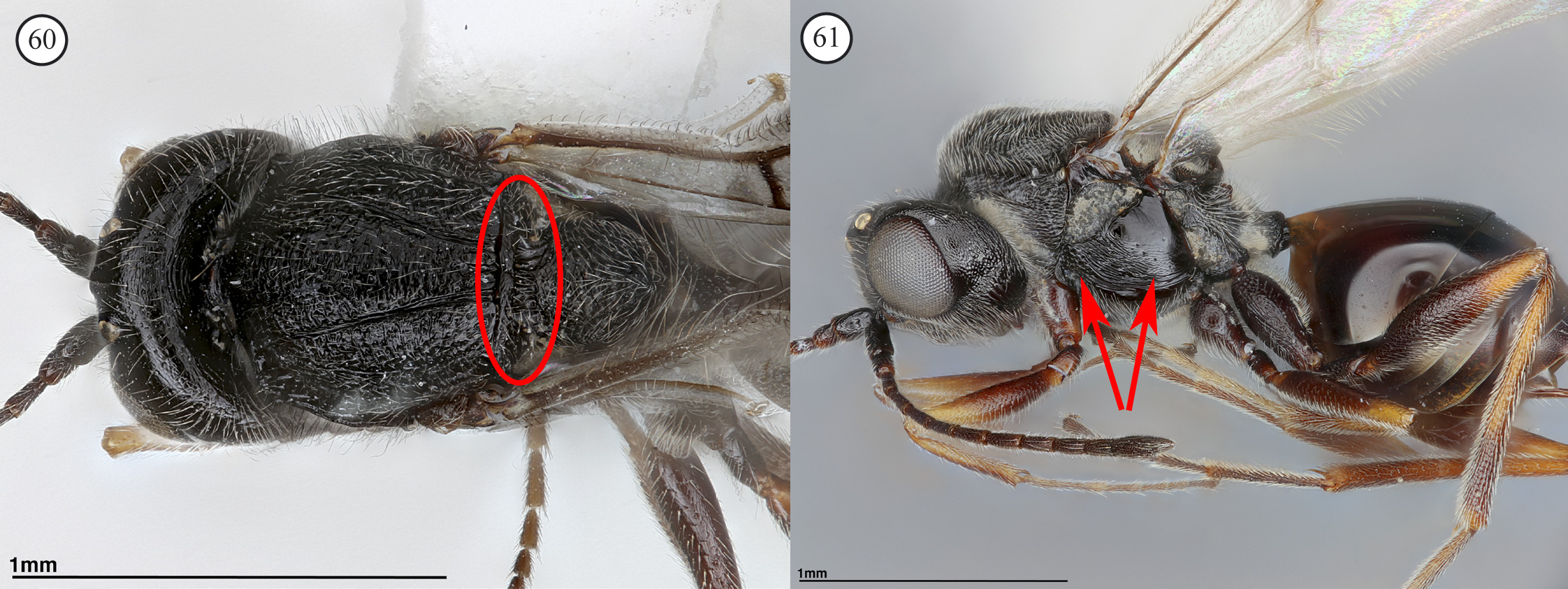
9. Scutellar foveae shallow, usually faint to completely absent
(oval, Fig. 60). Mesopleuron with a median longitudinal mesopleural impression,
sometimes very faint (arrows, Fig. 61); rarely the mesopleuron is almost
completely smooth and shining. Inhabiting galls on Nothofagus or inducing galls
on Acer (including the genus Hymalocynips from Nepal with biology
unknown). Rarely encountered ...10
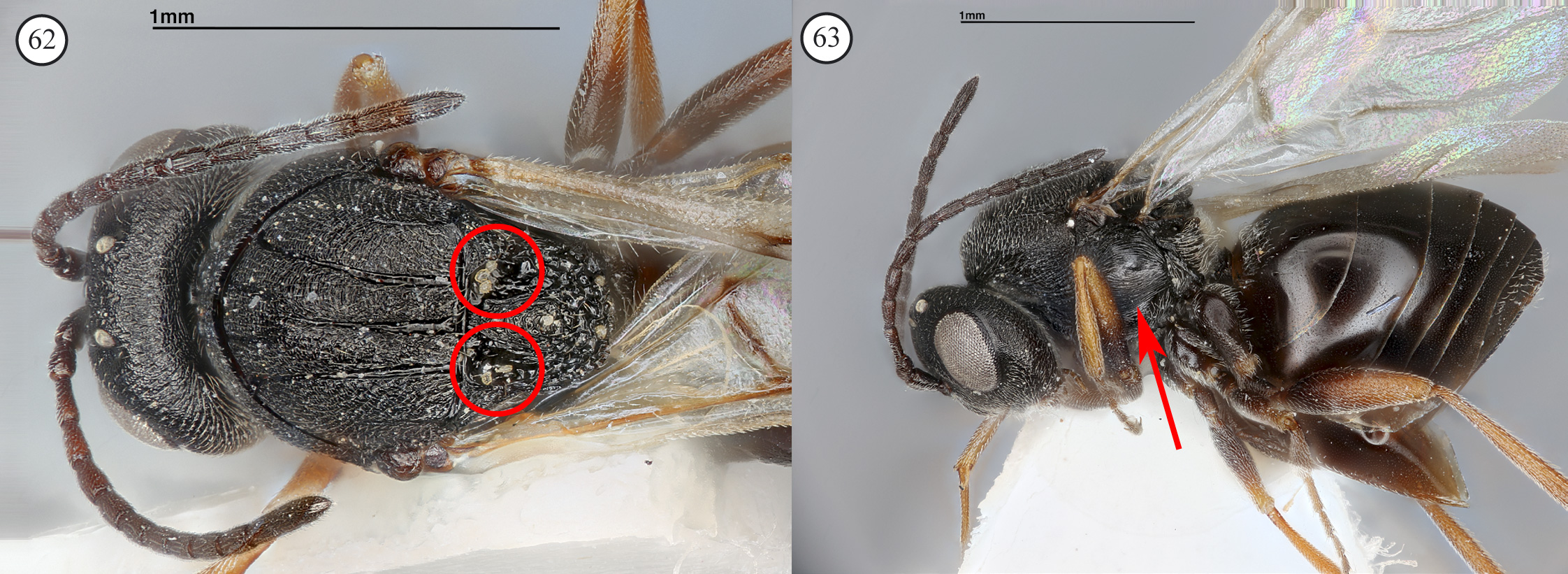
— Scutellar foveae usually well differentiated and deep,
sometimes confluent and forming a transverse depression (circles, Fig. 62).
Mesopleuron usually sculptured, without a median longitudinal impression (arrow,
Fig. 63) ...11
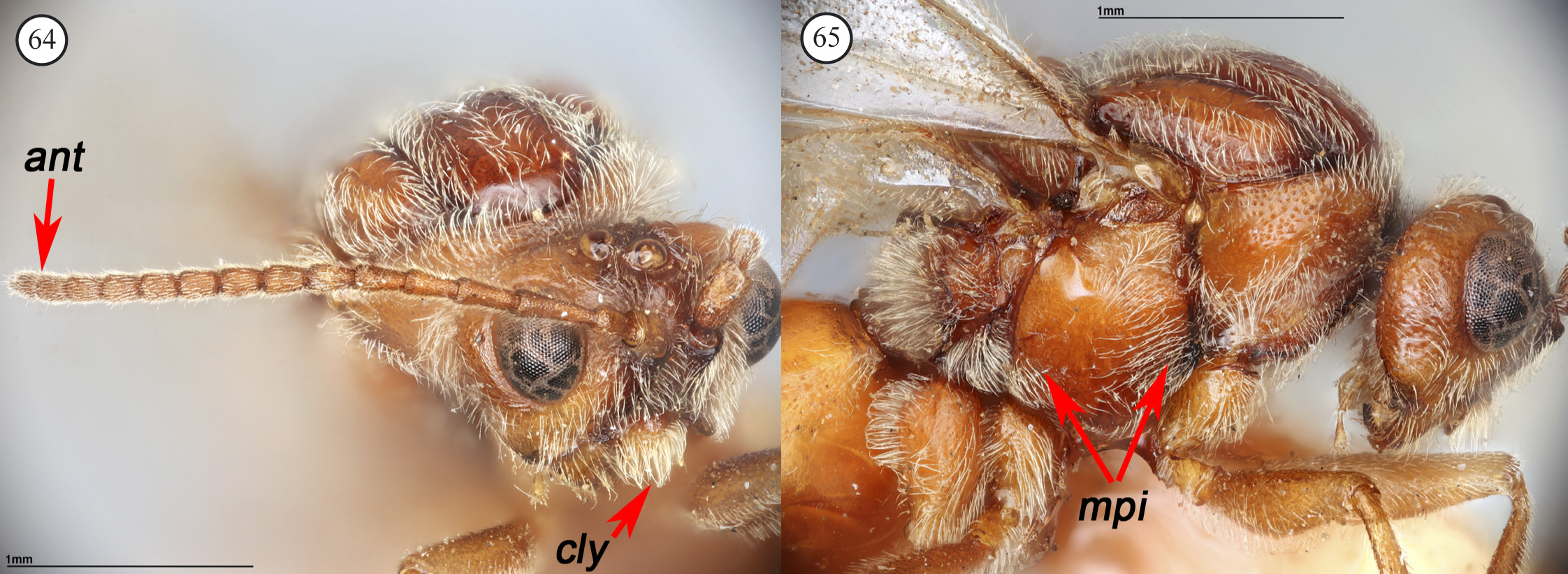
10. Female antenna with 12 or more flagellomeres; last
flagellomere not wider than the penultimate (ant, Fig. 64); male antenna without
modified F1; ventral area of gena without vertical carinae, genal carina absent;
ventral part of clypeus broadly projecting over mandibles (cly, Fig. 64);
dorsolateral margin of pronotal plate not projecting laterad (Fig. 65); area
posterior to transscutal fissure flat or convex; mesopleural impression absent
or faint (mpi, Fig. 65); profemur not modified; Palearctic gall-inducers on
Acer or biology unknown ...Pediaspidini
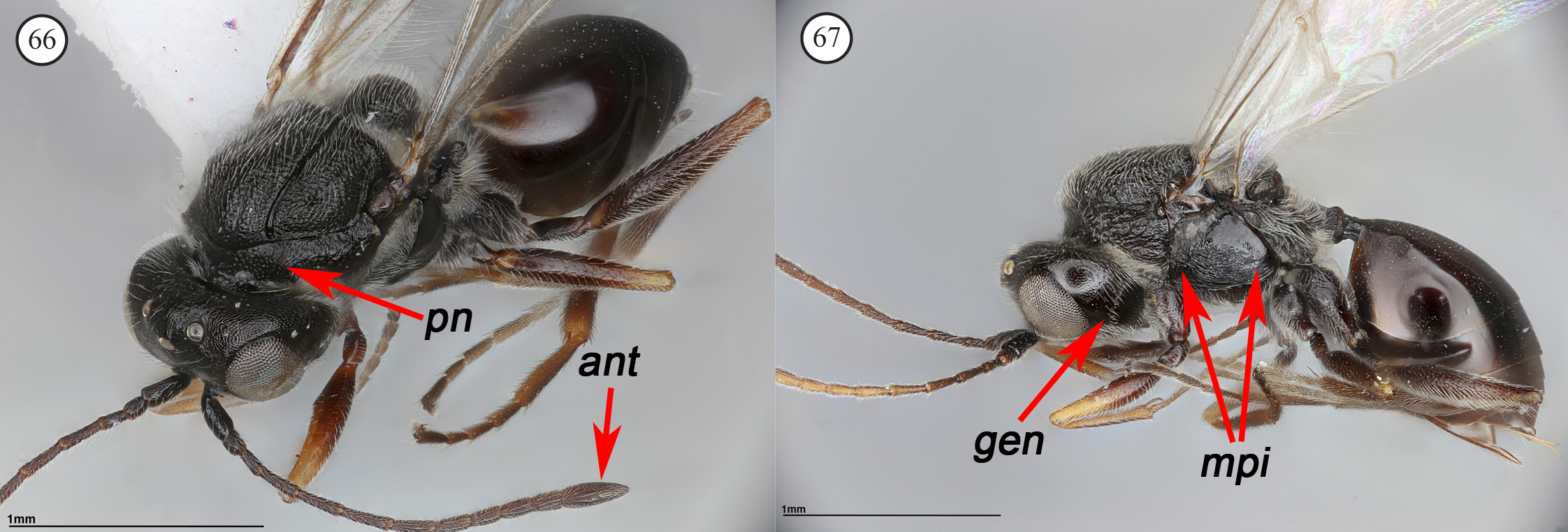
— Female antenna with 10 flagellomeres; last flagellomere wider
than the penultimate (ant, Fig. 66); male antenna with either F2, F3 or both
modified; ventral area of gena with 5–9 vertical carinae (gen, Fig. 67), genal
carina present; ventral part of clypeus at most slightly projecting over
mandibles; dorsolateral margin of pronotal plate strongly projecting laterad (pn,
Fig. 66); area posterior to transscutal fissure always concave; mesopleural
impression present (mpi, Fig. 67); profemur with ventral swelling composed of
4–5 rows of sharp, closely spaced, deep costulae; associated with Neotropical
galls on Nothofagus ...Paraulacini
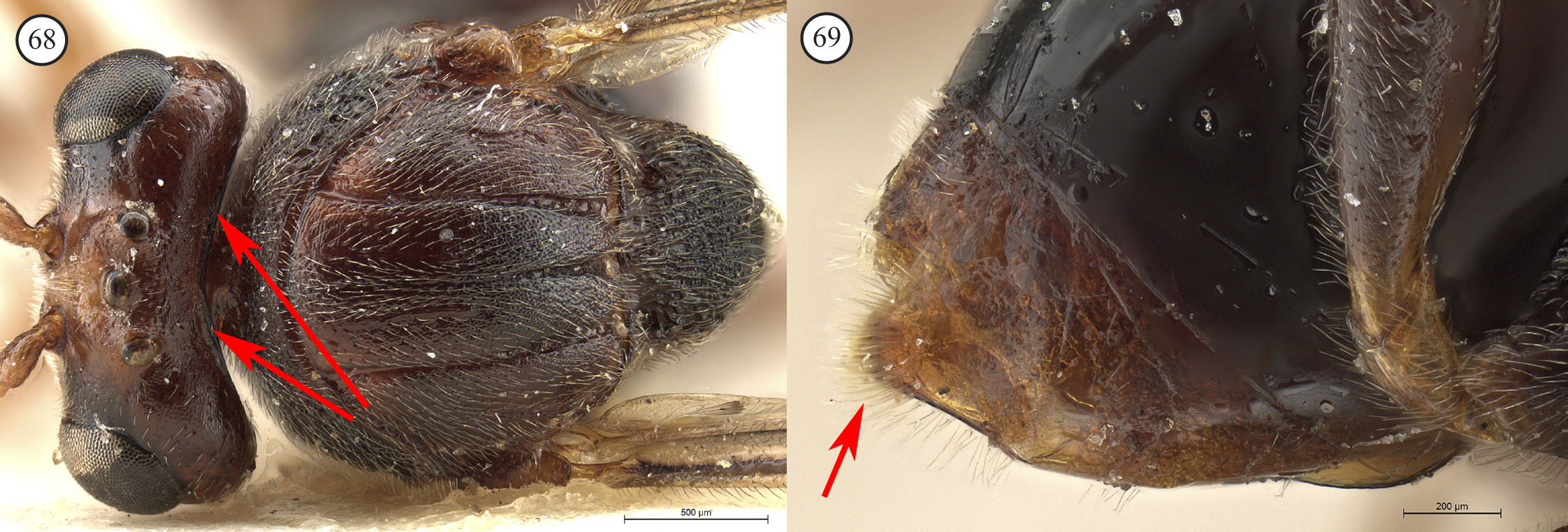
11. Occiput with strong and sharp occipital carina (arrow, Fig.
68); hypopygium abrupt, not prolonged into a ventral spine; with a dense tuft of
long setae (arrow, Fig. 69); South African gall-inducers on Scolopia.
Rarely encountered ...Qwaqwaiini
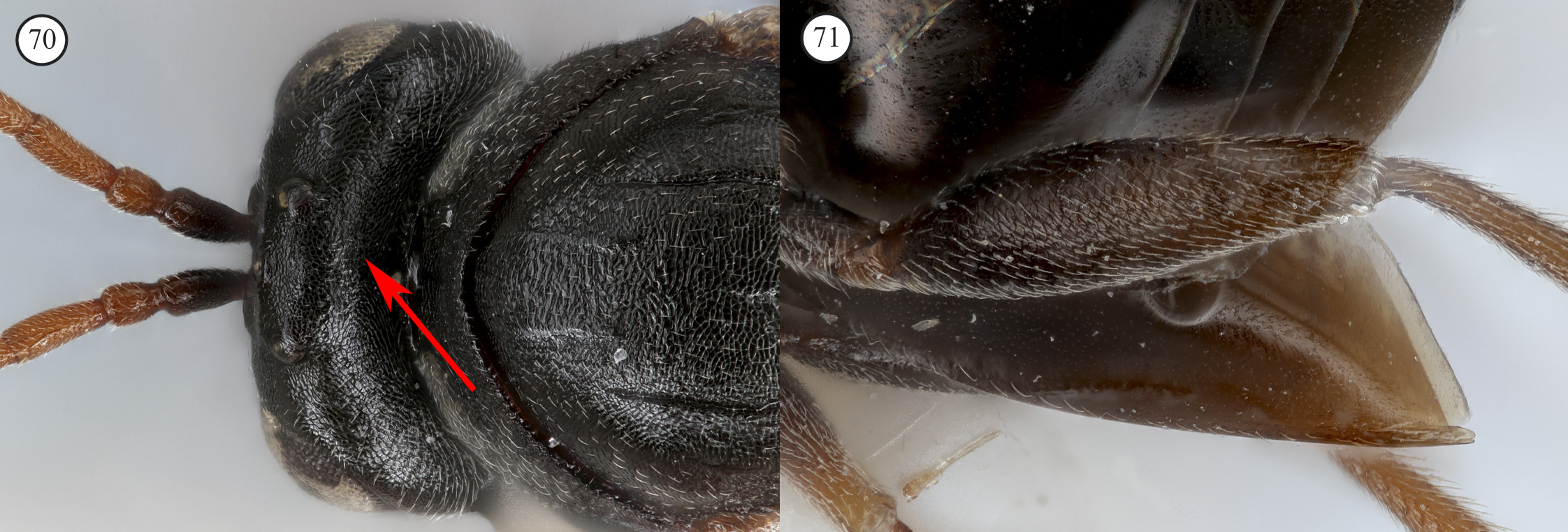
— Occiput without distinct and sharp occipital carina (arrow,
Fig. 70), sometimes with some strong parallel occipital rugae; hypopygium with
more or less distinct, elongated, needle-like ventral spine, with subapical
setae never forming a dense tuft (Fig. 71) ...12
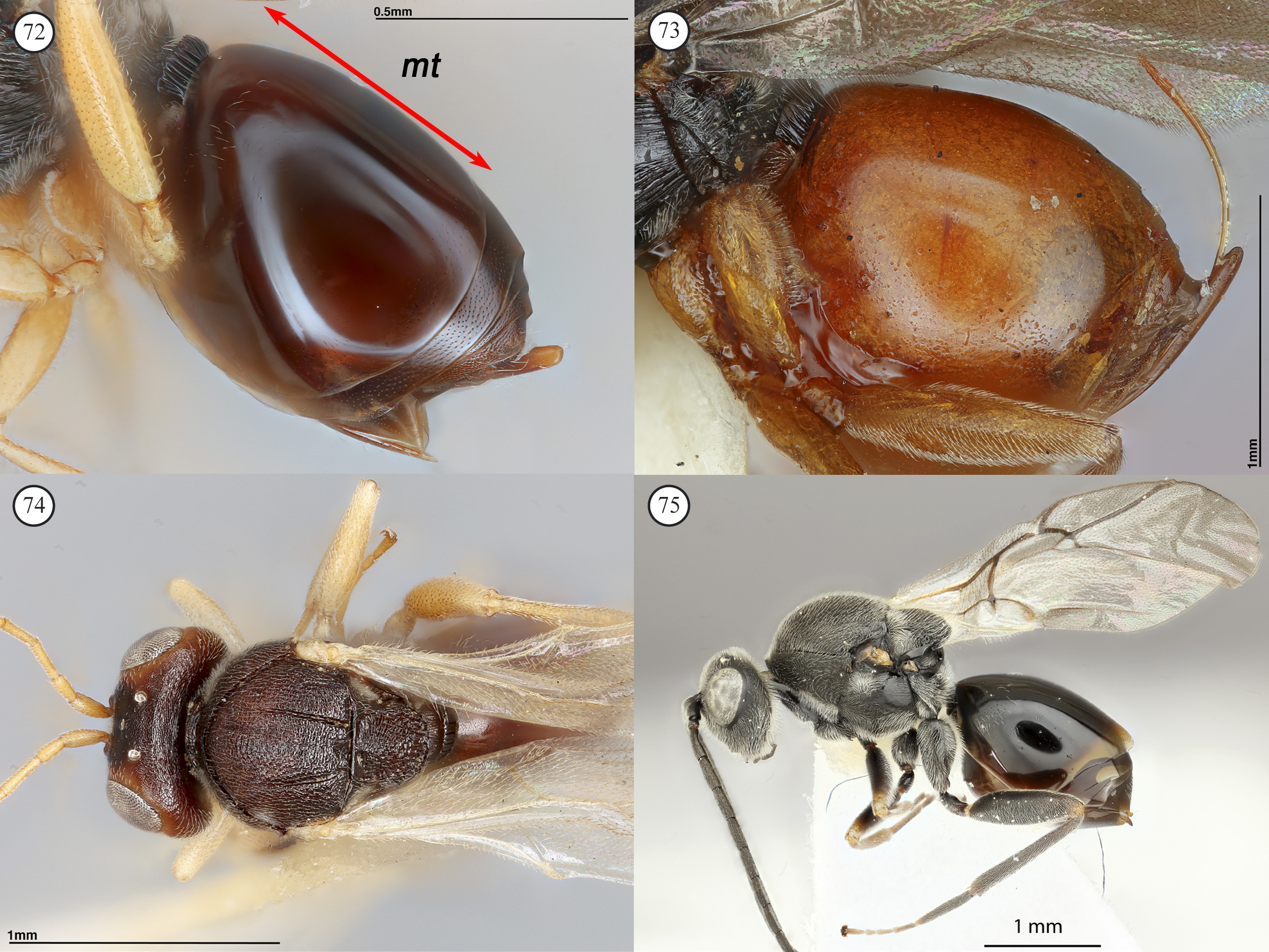
12. Metasomal tergites 2+3 fused, or apparently fused, into one
large segment occupying nearly entire metasoma (Figs 72 & 73), sometimes with
indistinct and continuous suture between these tergites in either sex; head and
mesosoma always sculptured (Figs 74 & 75); metasoma anteroventrally angled in
lateral view (mt, Fig. 72). Holarctic and Oriental inquilines in galls ...13
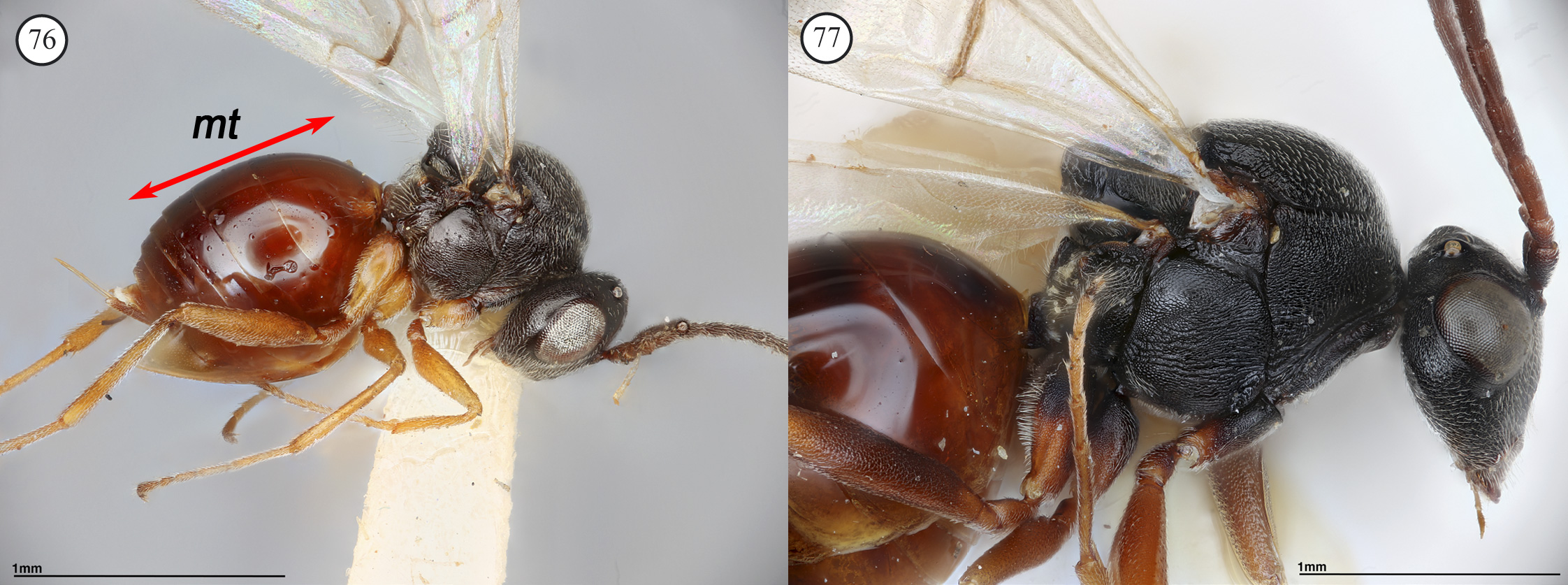
— Tergites 2–7 free in most cases (Fig. 76); if tergites 2+3
fused in females into one large segment then head and mesosoma almost smooth and
shiny (otherwise, head and mesosoma sculptured) (Fig. 77); metasoma usually more
or less oval in lateral view (mt, Fig. 76); Holarctic gall-inducers on
herbaceous plants or Rubus ...14
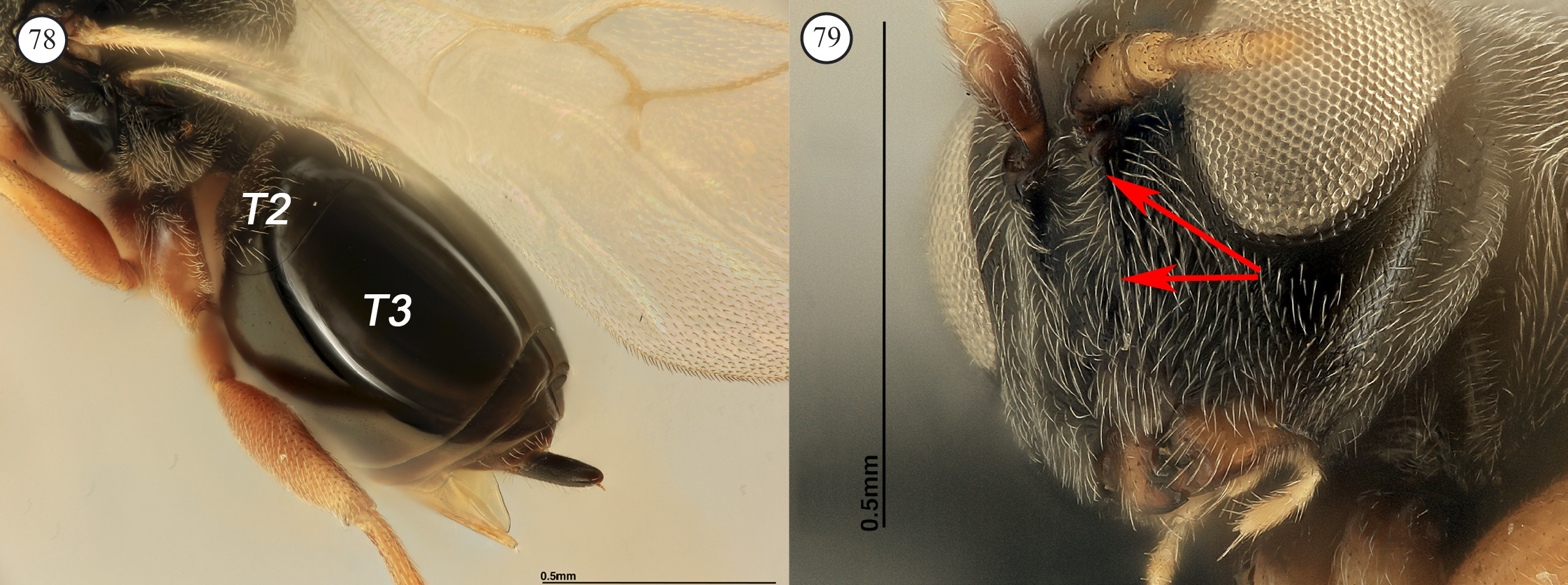
13. Metasomal T2 separated from T3 by suture; T2 much
smaller than T3 (Fig. 78); first tergum hardly visible (Fig. 78); depression
present ventral of torulus (arrows, Fig. 79); upper face, mesopleuron and vertex
smooth; metasoma hair patch often present; pronotal plate complete ...Ceroptresini
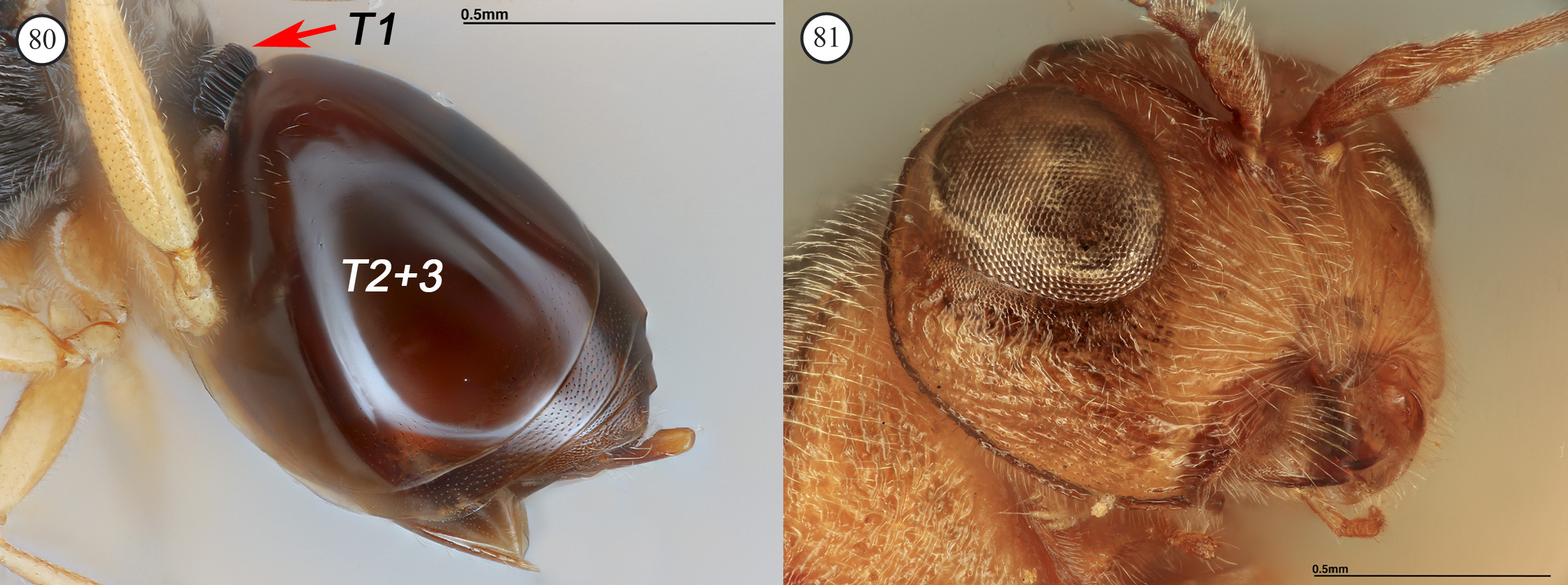
— Second and third tergum of metasoma fused into syntergum (T2+3,
Fig. 80); no suture present between T2 and T3; first tergum relatively large,
ring-like, longitudinally sulcate (arrow Fig. 80); depression absent ventral of
torulus (though striae
frequently present) (Fig. 81); upper face, mesopleuron and vertex with various
degrees of sculpture, not smooth; pronotal plate incomplete dorsally
...Synergini
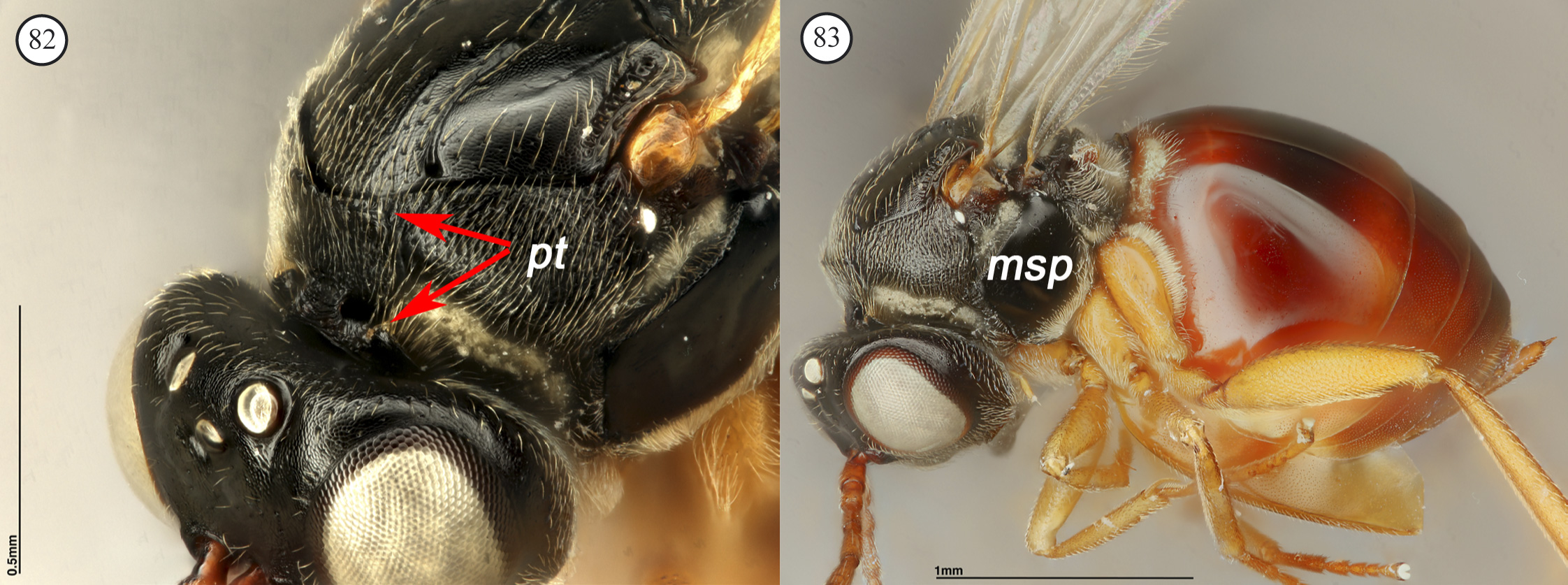
14. Pronotal plate present, defined dorsally and ventrally (pt.
Fig. 82); mesopleuron and mesosoma smooth (msp, Fig. 83); female with 10
flagellomeres in antenna; metatarsal claws with distinct lobe; gallers and
inquillines on roses ...Diastrophini
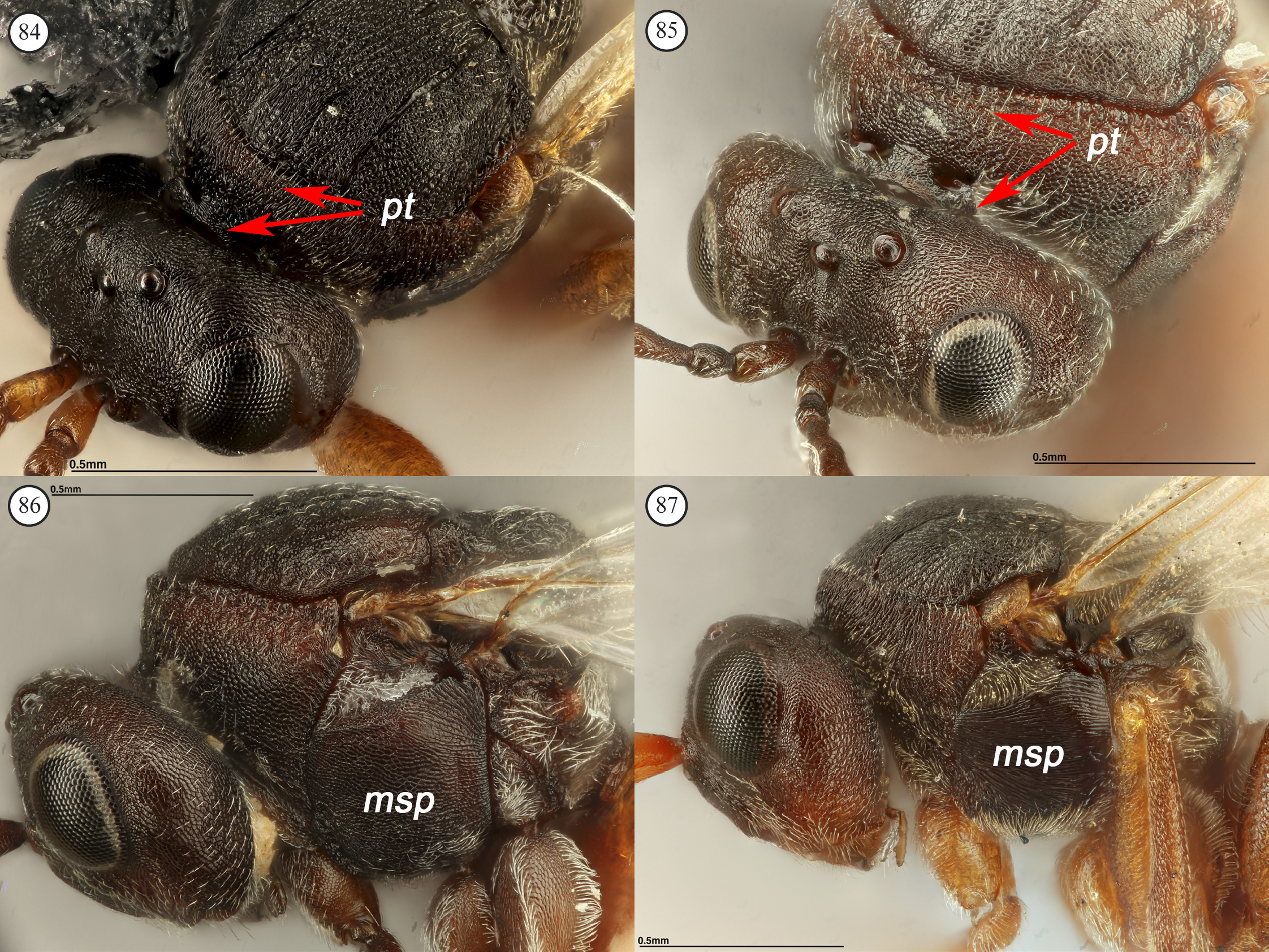
— Pronotal plate incomplete, not defined dorsally (pt, Figs 84 &
85); mesopleuron and mesosoma sculptured to various degrees (msp, Figs 86 & 87);
female antenna composed of 10-12 flagellomeres; metatarsal claws simple; gallers
on various herbaceous plants ...15

15. Mesopleuron with reticulate or rugulose sculpture (msp, Fig.
88); admedian depressions on pronotal plate effaced, shallow, and indistinct
(ad, Fig. 89); dorsal part of pronotal plate not reaching mesoscutum (pt, Fig.
89); R1 in forewing reaching anterior margin of wing (R1, Fig. 90), and marginal
cell at least partially closed (Fig. 90); gallers on Asteraceae, rarely on other
plants ...Phanacidini
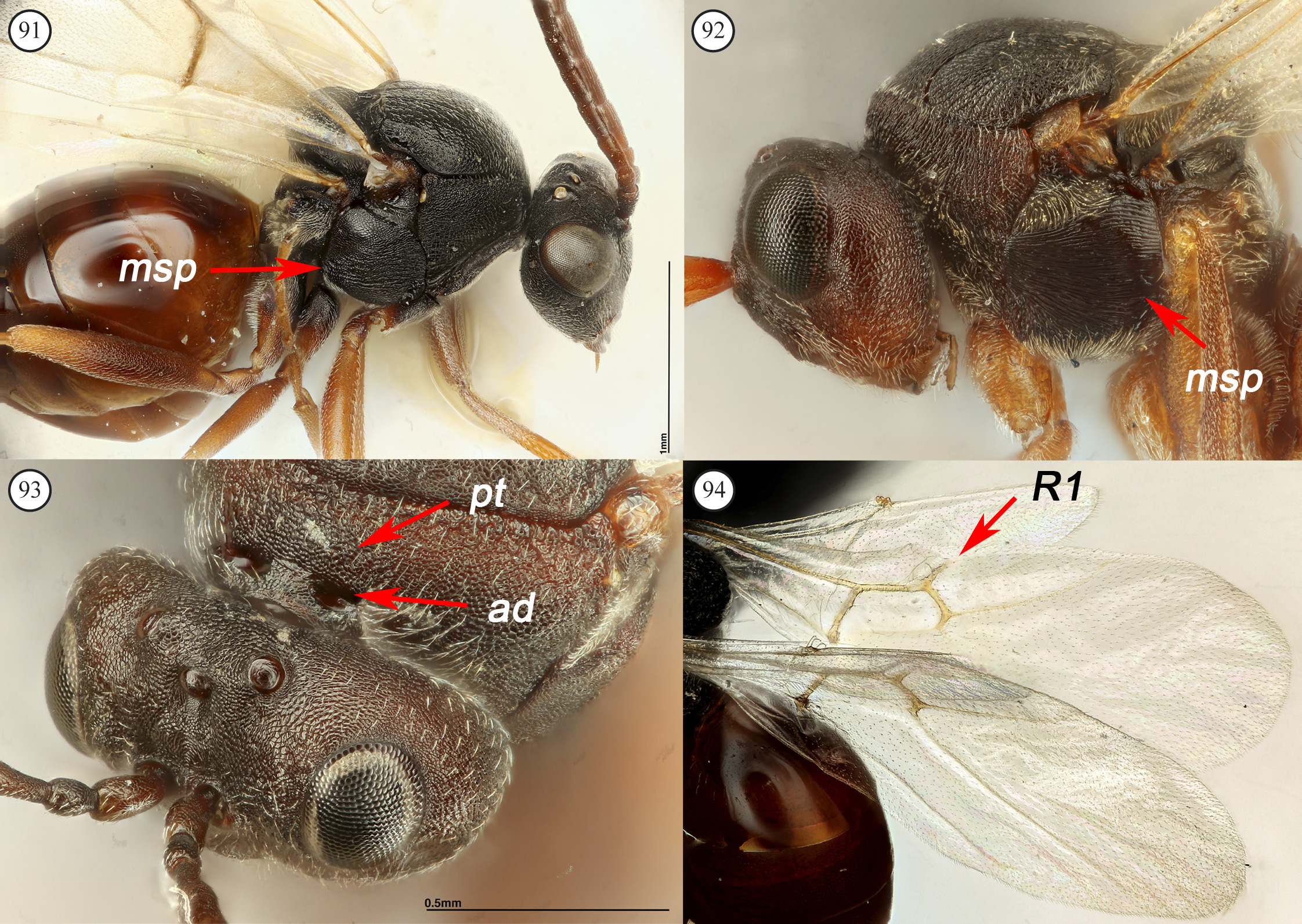
— Mesopleuron longitudinally striate, striate-reticulate, or
smooth, never rugulose (msp, Figs 91 & 92); admedian depressions of pronotal
plate present, typically separated (ad, Fig. 93); dorsal part of pronotal plate
typically reaching mesoscutum; R1 of forewing reaching or not reaching wing
margin (R1, Fig. 94); marginal cell open or closed (Fig. 94) ...16
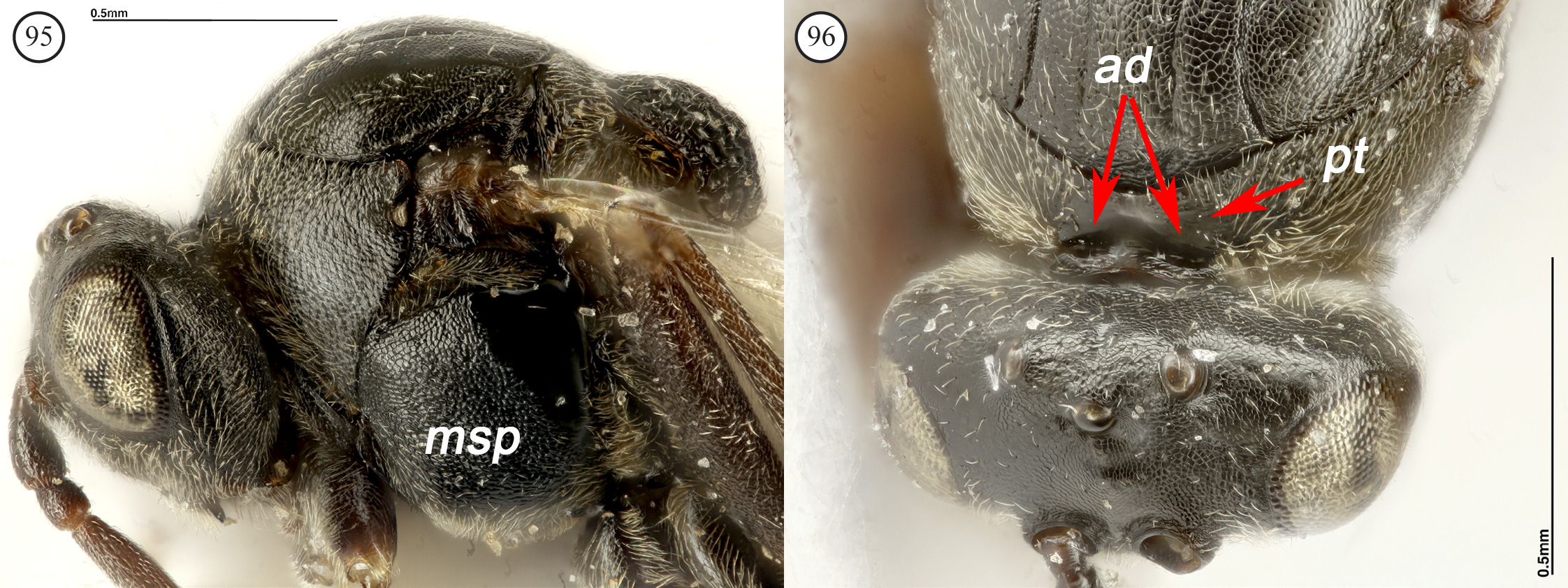
16. Mesopleuron striate-reticulate (msp, Fig. 95); female antenna
with12 flagellomeres; pronotum (in dorsal view) short, about 1/5 as long as
greatest length of outer margin (pt, Fig. 96); admedian depressions narrowly
separated and strongly transverse (ad, Fig. 96); gallers on Papaver
(Papaveraceae) ...Aylacini
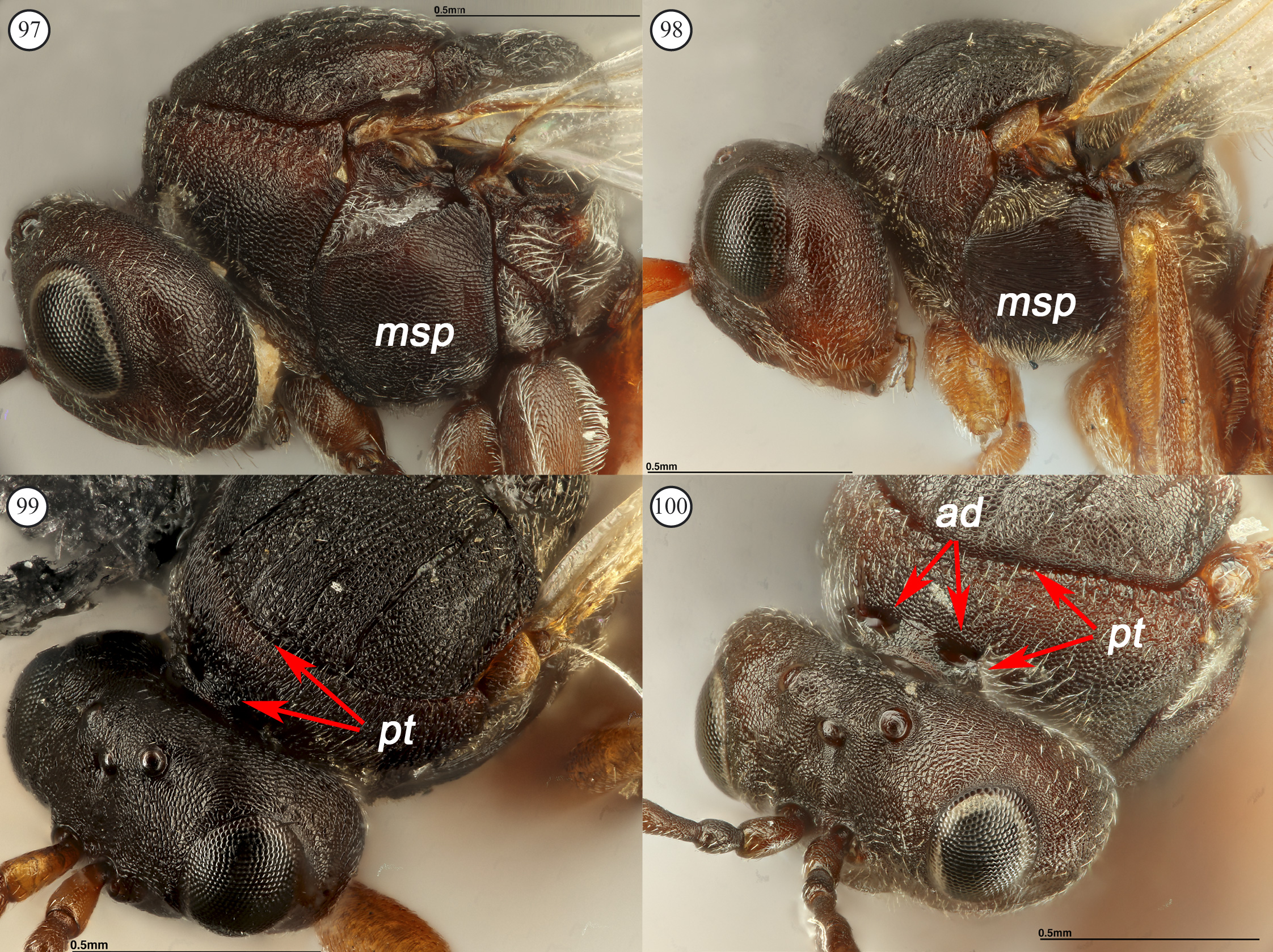
— Mesopleuron longitudinally striate (msp, Figs 97 & 98); female
antenna with 10-11 flagellomeres; pronotum (in dorsal view) longer, about 1/3 to
1/4 as long as greatest length of outer margin (pt, Figs 99 & 100); admedian
depressions oval or round, usually more widely separated (ad, Fig. 100); gallers
on Asteraceae, Lamiaceae, Valerianaceae, and Papaveraceae ...Aulacideini
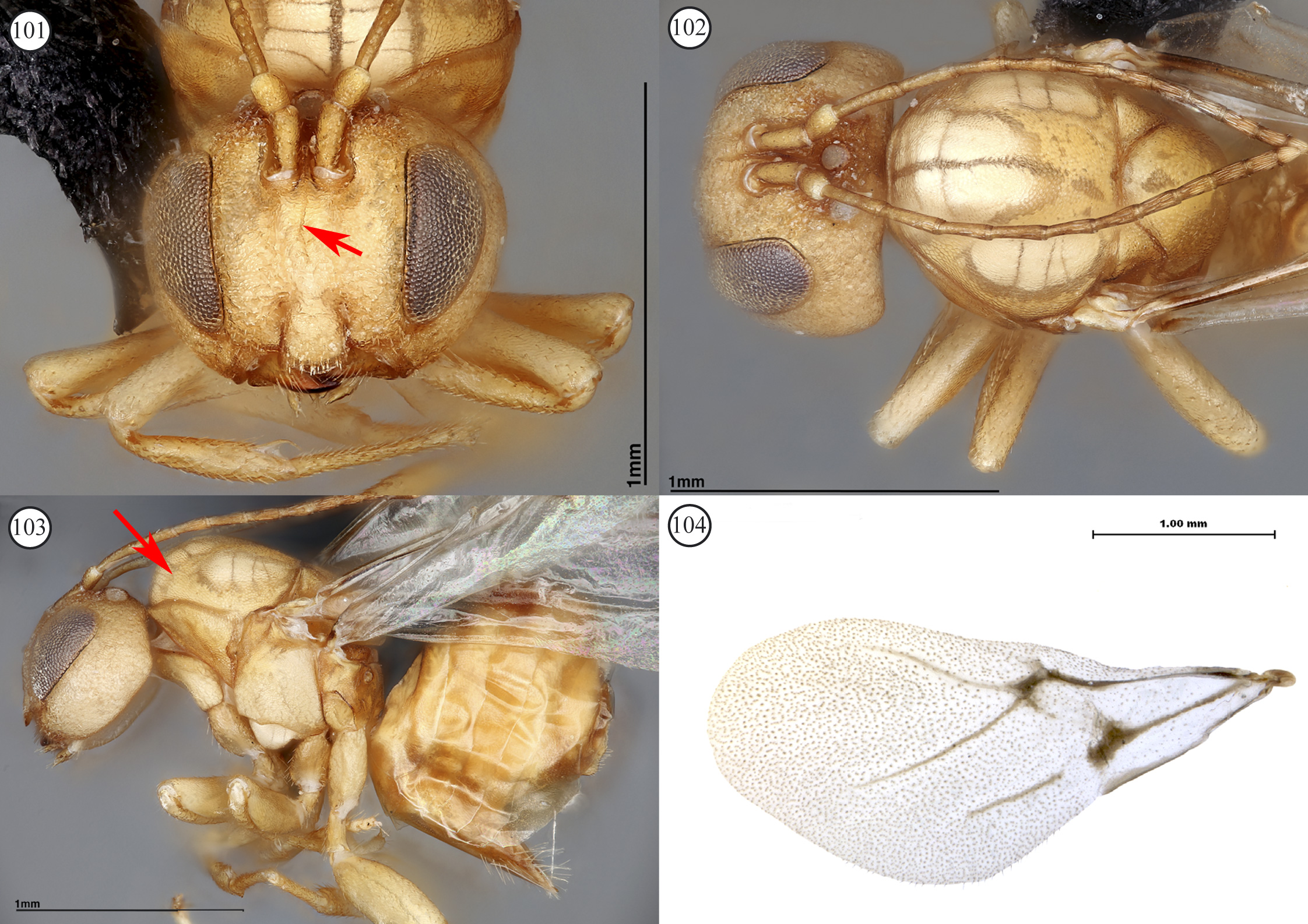
17. Frons between antennal toruli with strong longitudinal carina
(arrow, Fig. 101); notauli and scutellar foveae absent (Fig. 102); mesoscutum
bulging above pronotum (arrow, Fig. 103); Rs+M and R1 of forewing inconspicuous,
radial cell with Rs separate from anterior wing margin; basal vein absent (Fig.
104); Neotropical gall-inducers on Acacia or Prosopis
...Eschatocerini
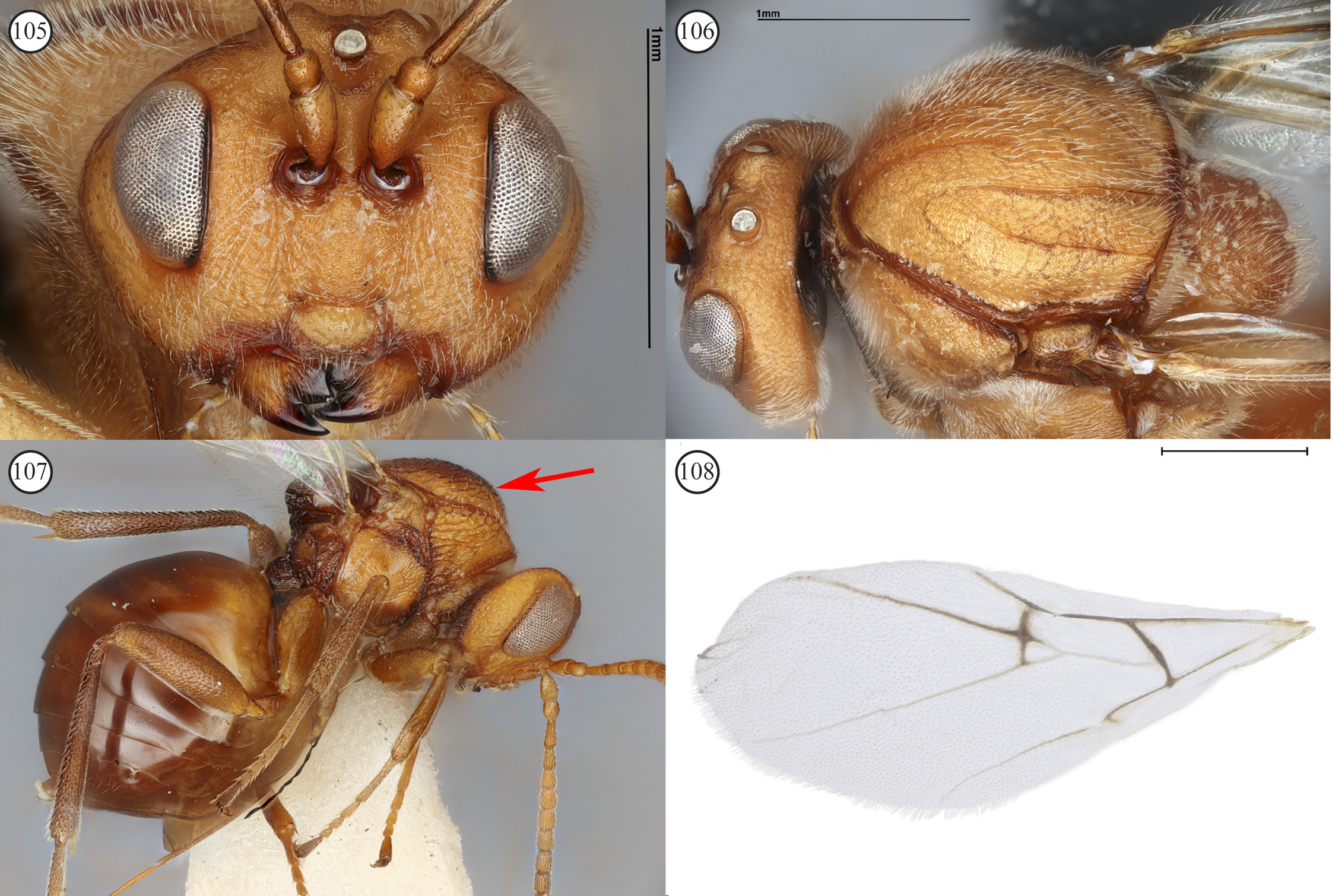
— Frons usually without median carina (Fig. 105); if present,
(some Plagiotrochus) then it is not so strong; notauli complete, incomplete or
absent (Fig. 106); scutellar foveae present or confluent, forming shallow
transverse depression in lateral view; mesoscutum not bulging above pronotum
(arrow, Fig. 107); Rs+M and R1 of forewing usually present and visible, Rs
reaching or almost reaching anterior wing margin; basal vein present (Fig. 108);
gall-inducers on Fagaceae or Rosa ...18
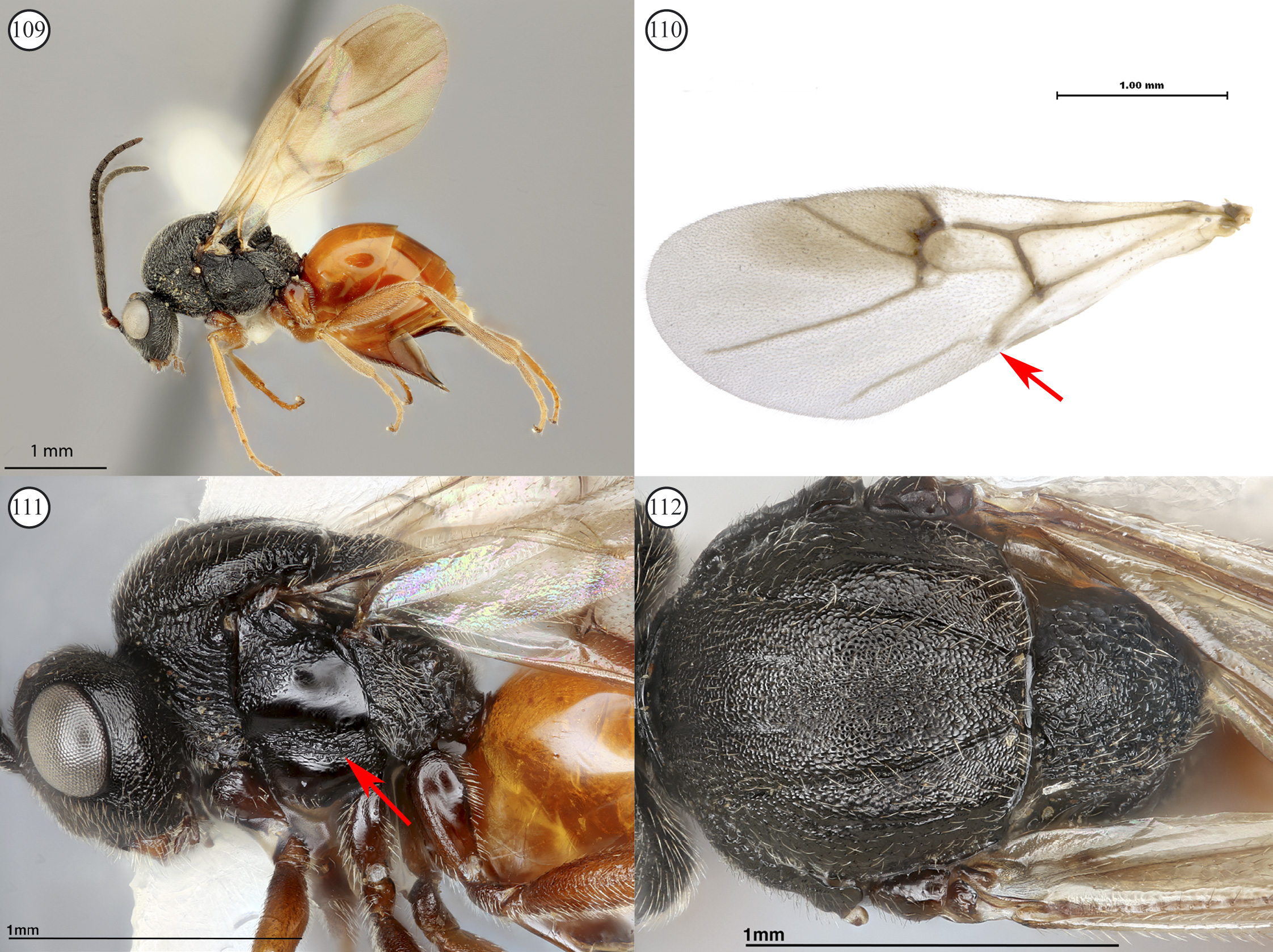
18. Mesopleuron with a broad, crenulate mesopleural impression
(arrow, Fig. 111); usually with a combination of the following characters:
hypopygium plough-shaped (arrow, Fig. 109); lateral propodeal carinae
indistinct; scutellar foveae faint or absent (Fig. 112); 2r of forewing with a
median vein stump projecting distad (arrow, Fig. 110); Holarctic gall-inducers
on Rosa ...Diplolepidini
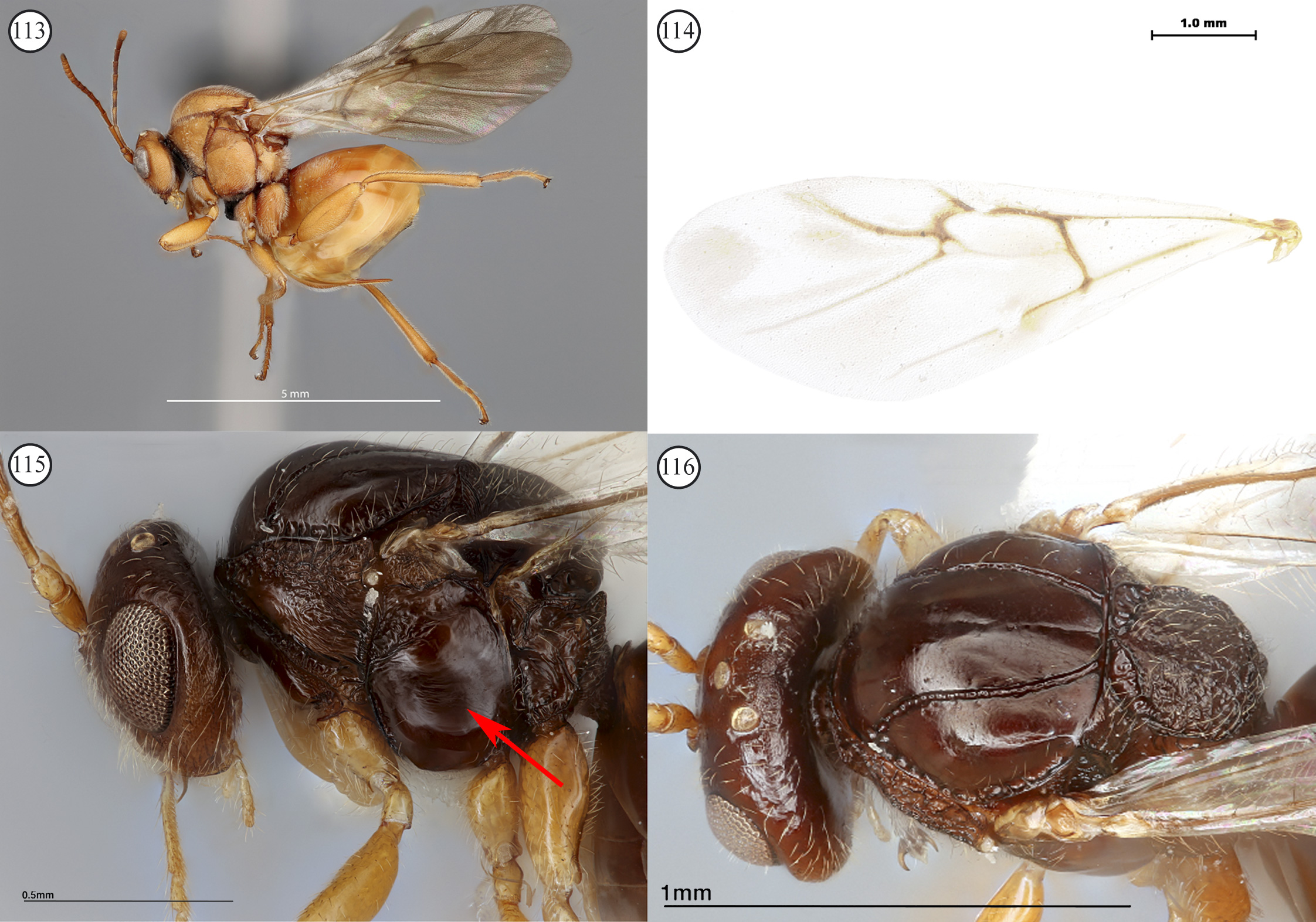
— Mesopleuron usually without a mesopleural impression (Fig. 113;
arrow, Fig. 115); without other characters combined (Figs. 113-116); Holarctic
and Oriental gall-inducers on Fagaceae, mainly Quercus ...Cynipini
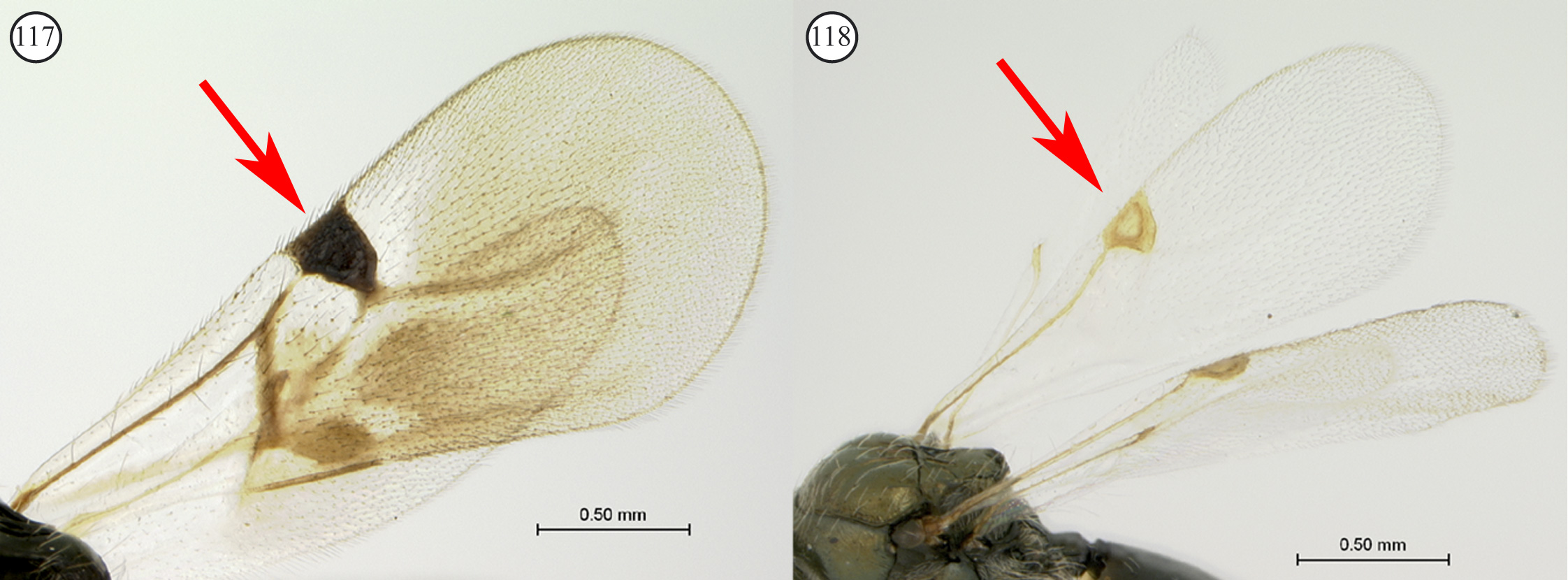
19. Marginal cell sclerotised into a pseudostigma (arrows, Figs
117 & 118). Afrotropical and southeastern Palearctic/Middle East
...Pycnostigminae
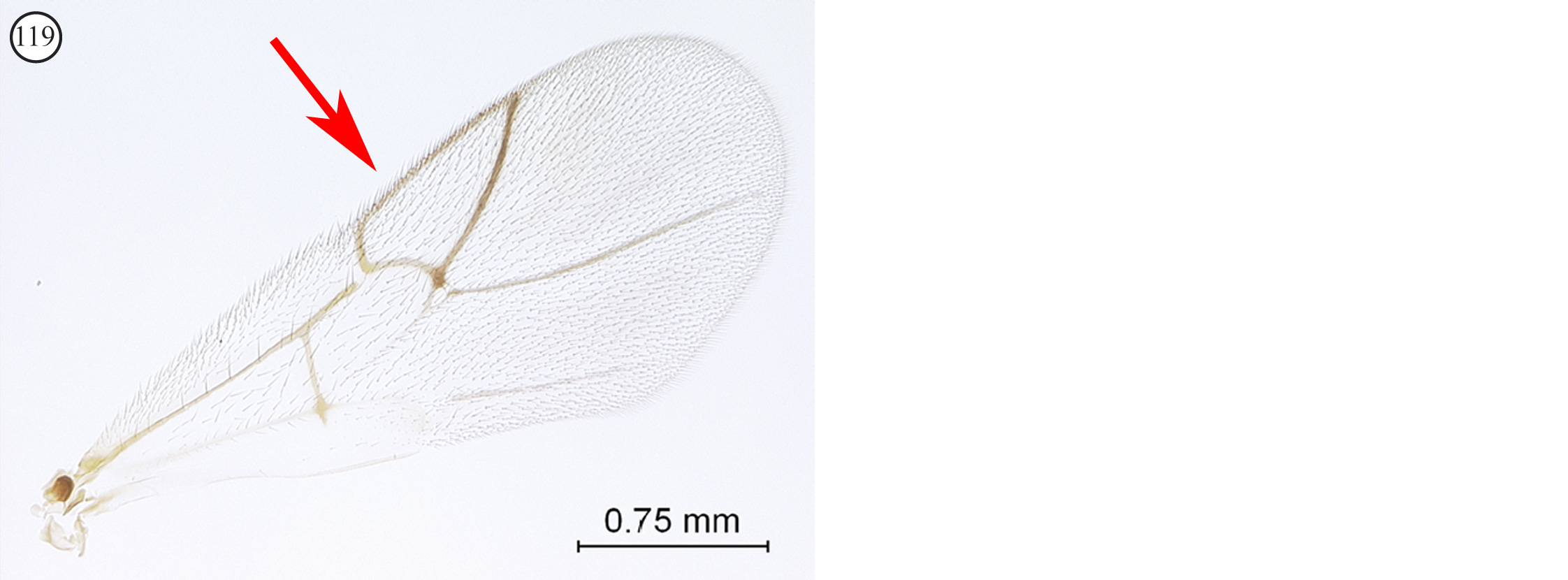
— Marginal cell not sclerotised (arrow, Fig. 119) ...20

20. Scutellum with an elevated scutellar plate with
a central glandular release pit (Figs 120-122) ...Eucoilinae
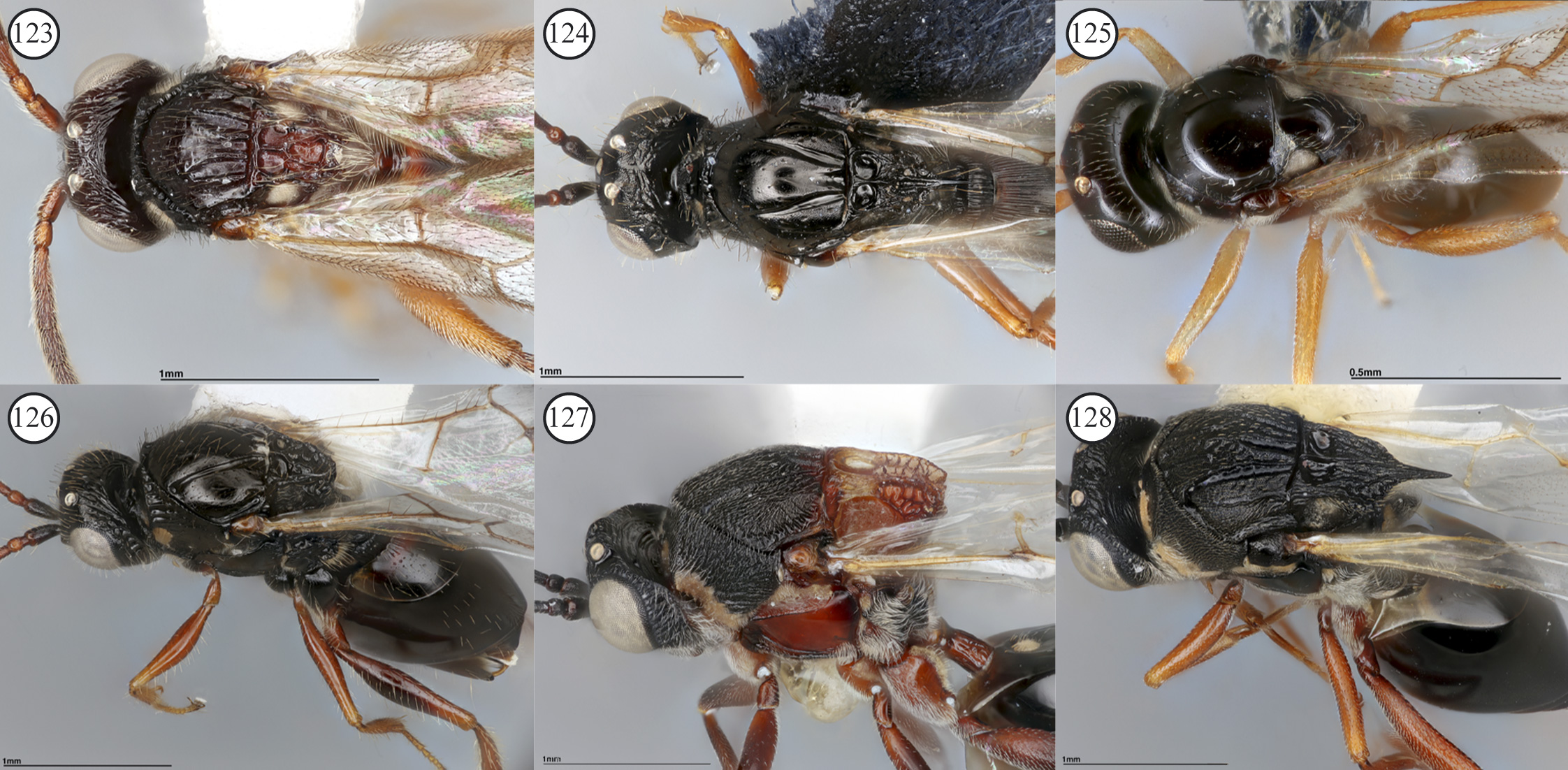
— Structure of scutellum variable, posterior surface relatively
flat or evenly convex, never with a distinct elevated plate and associated
posterior release pit (Figs 123-128) ...21
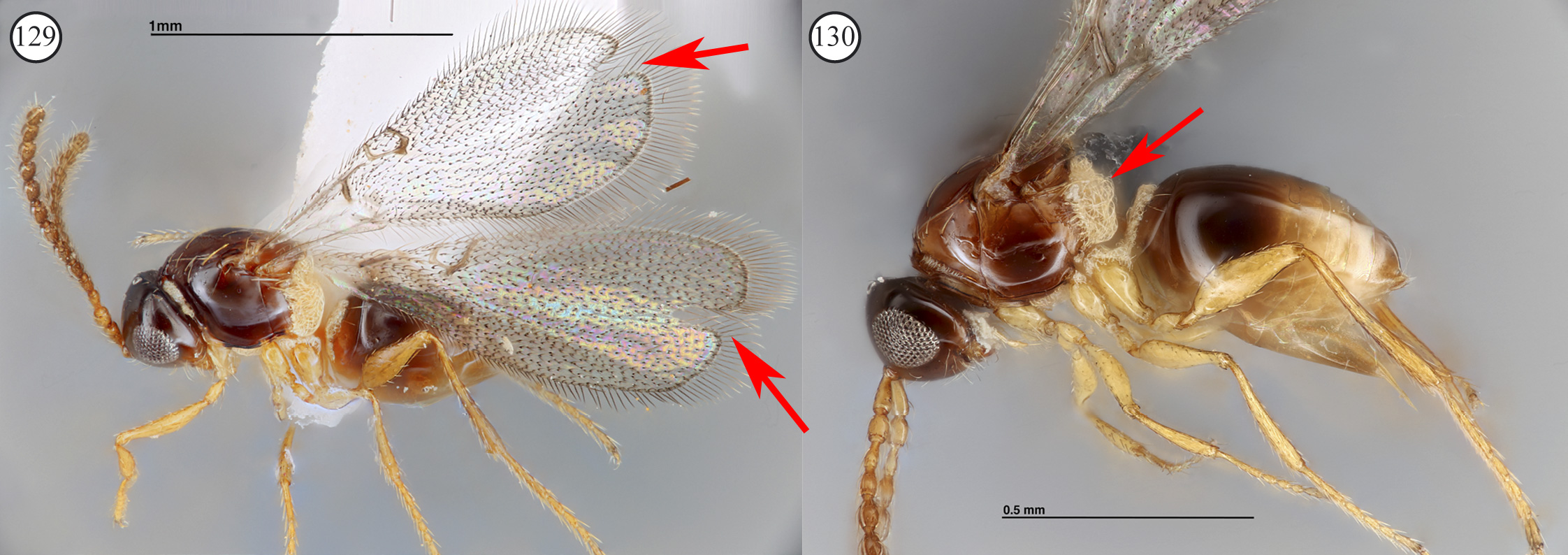
21. Apex of forewing deeply bilobed (arrow, Fig. 129). Often
raised median area on scutellum. Densely packed (foamy) setae present on
propodeum (arrow, Fig. 130). Typically 1.5 mm in length ...Emargininae
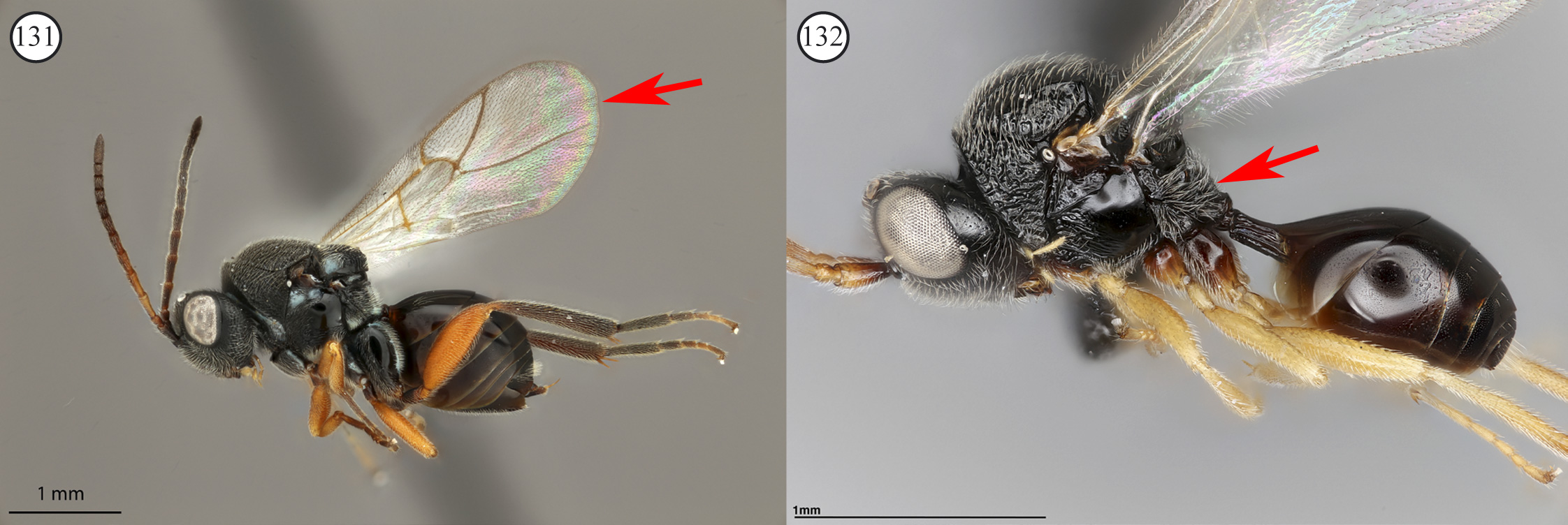
— Apex of forewing rounded (arrow, Fig. 131). Propodeum variously
setose to glabrous, never with densely packed setae (Fig. 132) ...22
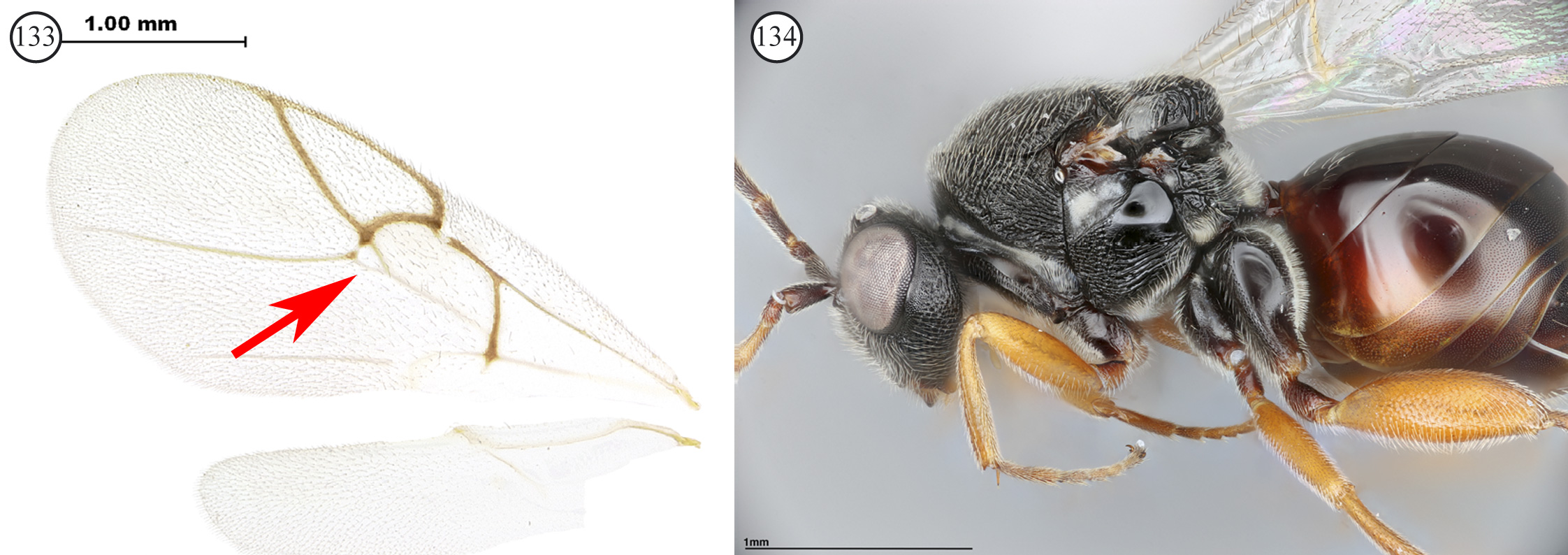
22. Areolet present (arrow, Fig. 133); more or less cynipid-like;
base of metasoma setose or glabrous (Fig. 134) ...23
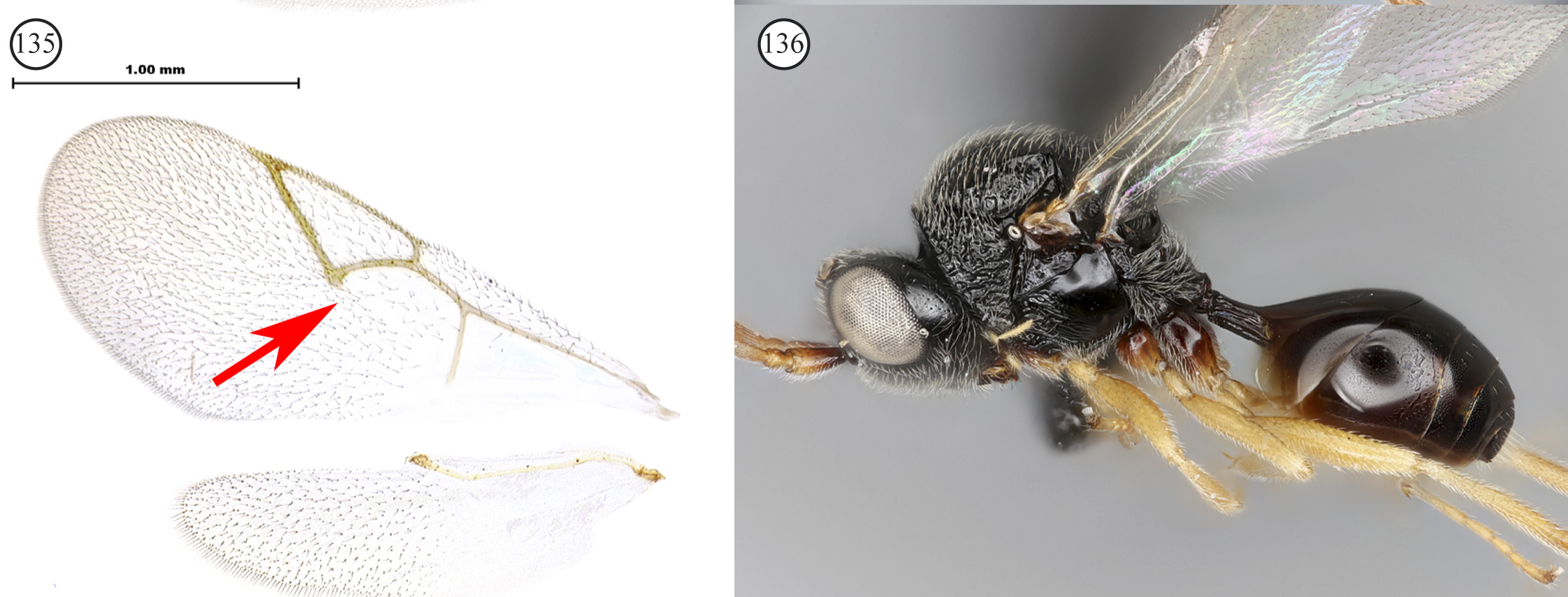
— Areolet absent (arrow, Fig. 135); base of metasoma glabrous
(Fig. 136) ...25

23. Head and mesoscutum generally coriacious to foveate, and
frequently setose (Fig. 137) ...24

— Head and mesoscutum generally smooth, lacking dense setal
patterns, but some stout setae present (Fig. 138) ...some
Figitinae

24. Mesopleuron striate, with no indication of distinct
mesopleural furrow (arrow, Fig. 139). Mediterranean, on Papaver ...Parnipinae

— Mesopleuron dorsally smooth, ventrally striate along the
distinct mesopleural furrow (arrow, Fig. 140). Nearctic, on Quercus
...Euceroptrinae
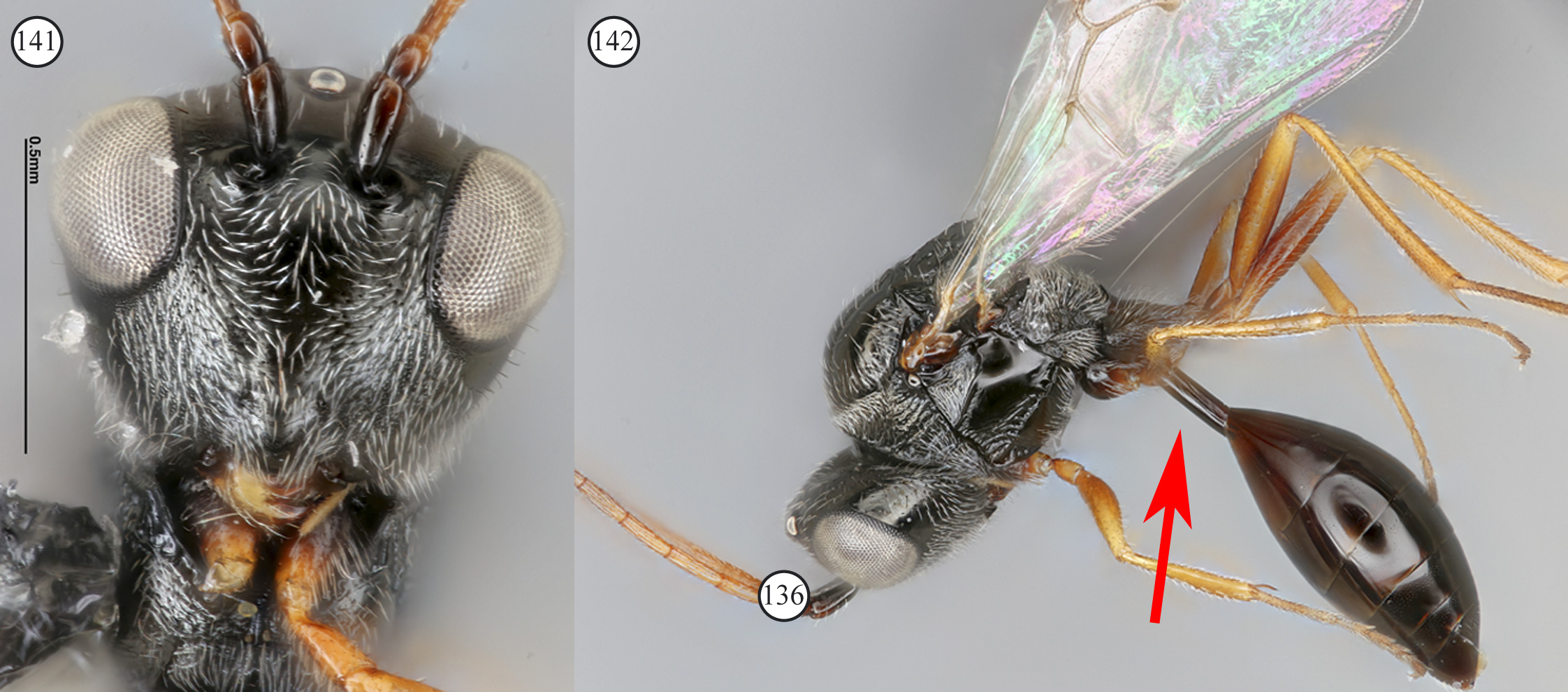
25. Head generally triangular in anterior view; mouth small, with
broadly overlapping mandibles (Fig. 141). Petiole often long (arrow, Fig. 142).
First metasomal tergite subequal in length to second, sometimes longer
...Anacharitinae
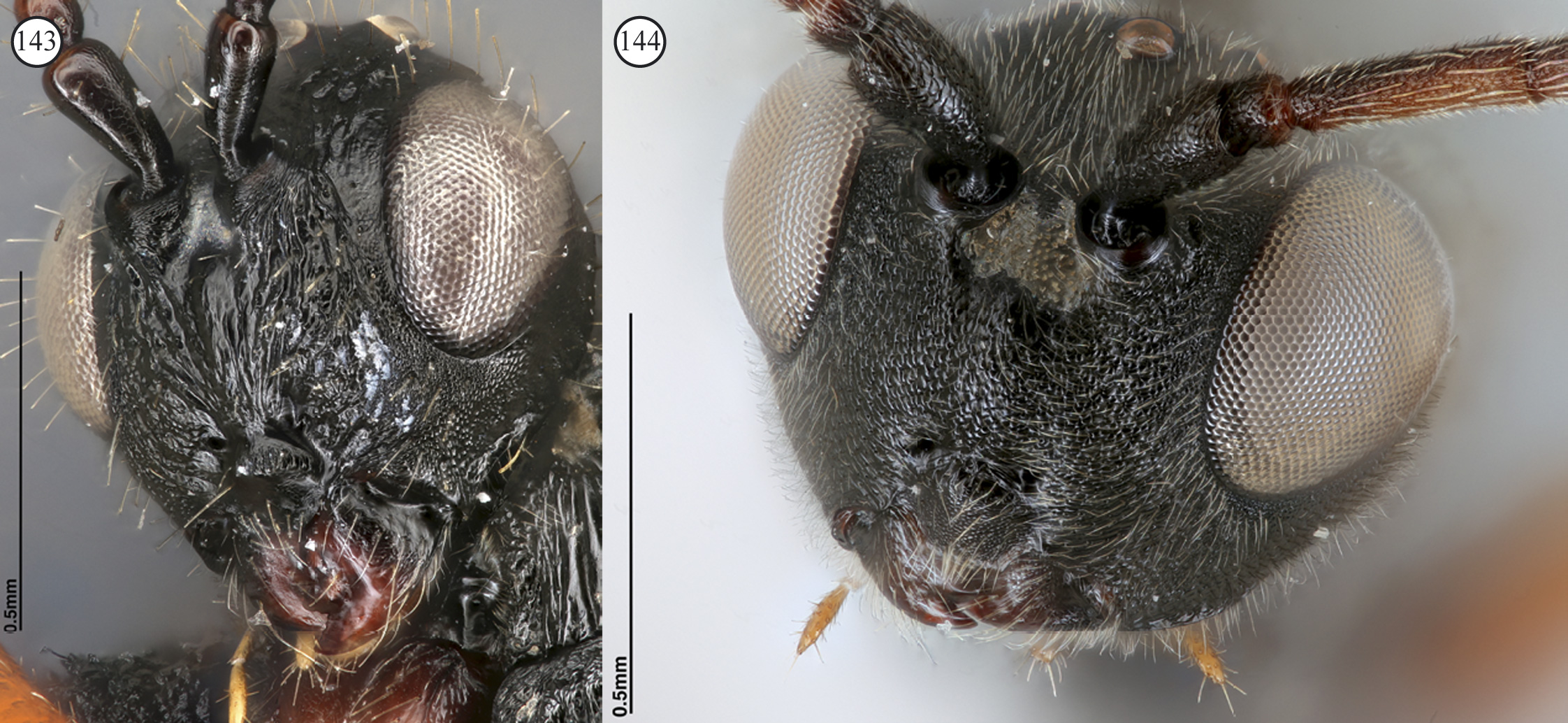
— Head oval to round in anterior view (Figs 143 & 144); mouth
region broadened, mandibles larger and not extensively overlapping. Petiole
typically not elongate ...26

26. Scutellum evenly convex, rounded, shiny and smooth (arrows,
Figs 145 & 146). Usually tiny, very often pale in colour (Fig. 147). Mesoscutum
usually shiny and smooth (Figs. 145-147) ...Charipinae

— Scutellum flat or weakly convex, and sculptured (Figs 148-150).
Usually darker, typically black. Mesoscutum usually with transverse ridges or
distinct microsculpture (Figs 148-150) ...27

27. Metatibial spur remarkably long, more than half the length of
basal tarsomere (arrows, Figs 151 & 152; Fig 153) . Neotropical; associated with
Nothofagus forests. Rarely encountered ...Plectocynipinae

— Metatibial spur not remarkably long, at most a quarter of
length of first tarsomere (arrow, Fig. 154) ...28
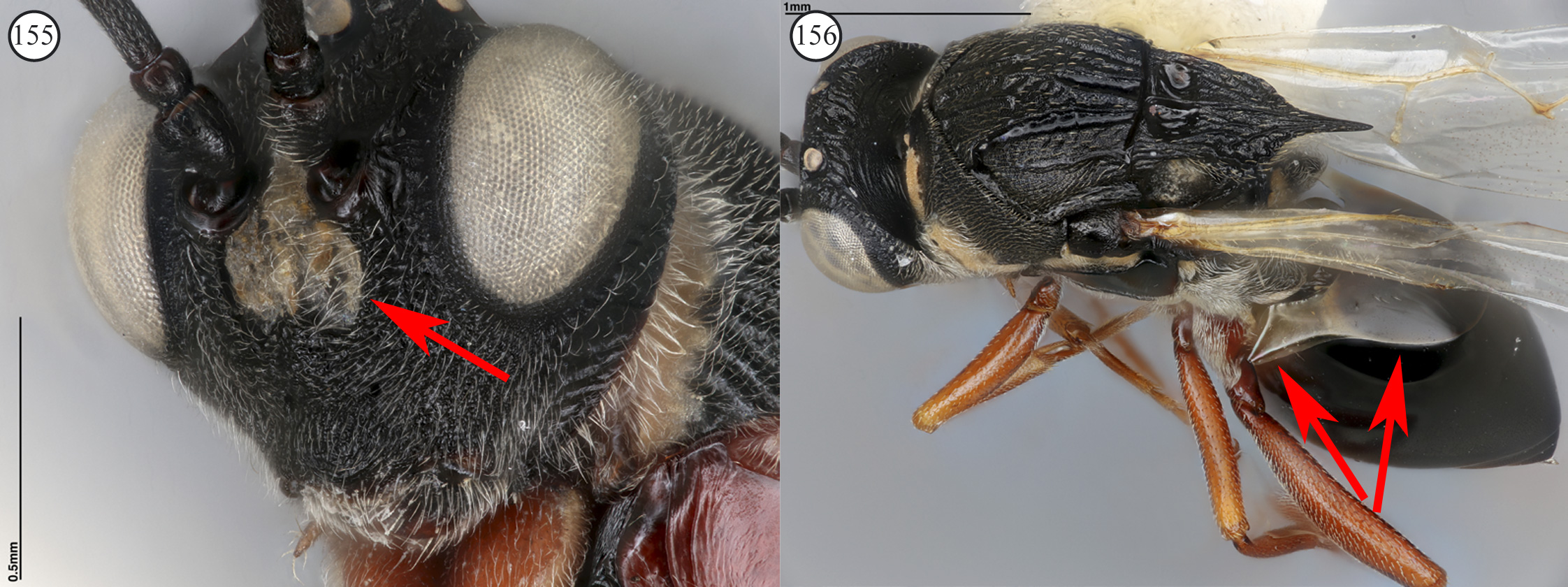
28. Facial impression present (arrow, Fig. 155). First metasomal
tergite saddle-like with concave posterolateral margin and more or less
linguiform median part (arrows, Fig. 156). Often relatively large, with a well
sculptured body, often red in colour, and wings with strongly reduced pubescence
and accessory veins ...core
Aspicerinae
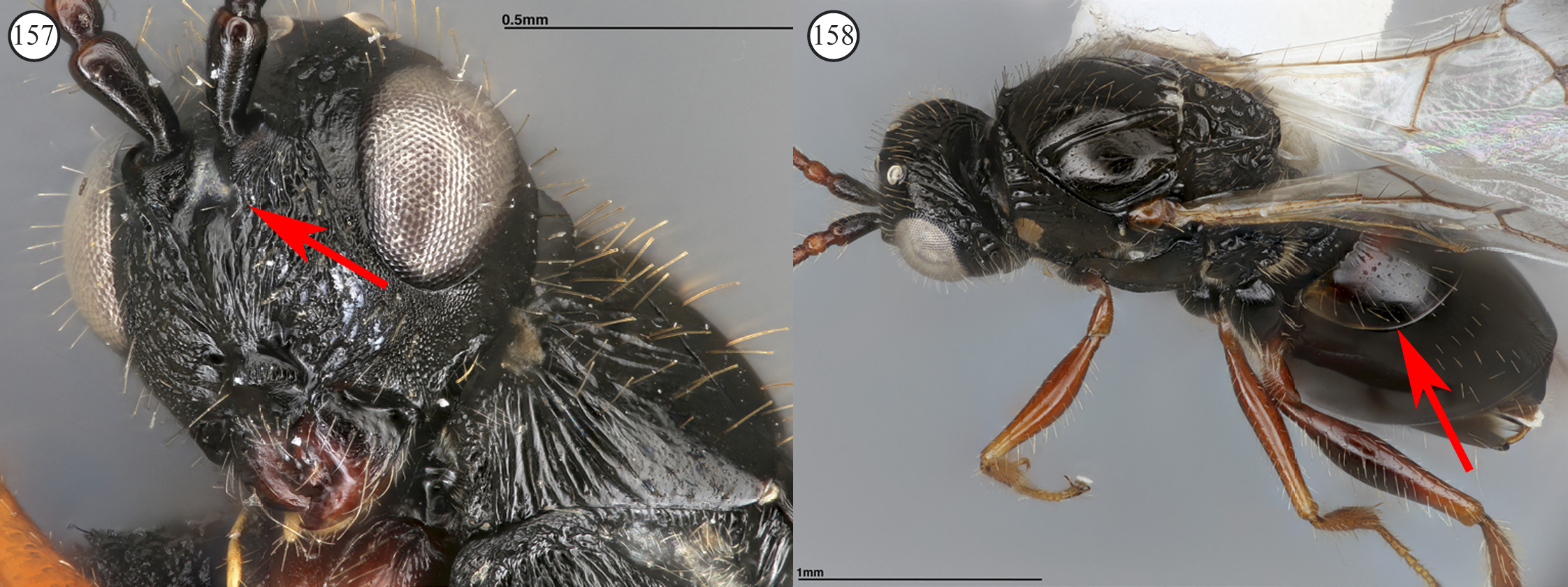
— Facial impression absent (arrow, Fig. 157). First metasomal
tergite rounded, usually with a convex margin (arrows, Fig. 158). Size varying
from relatively large to very small ...29
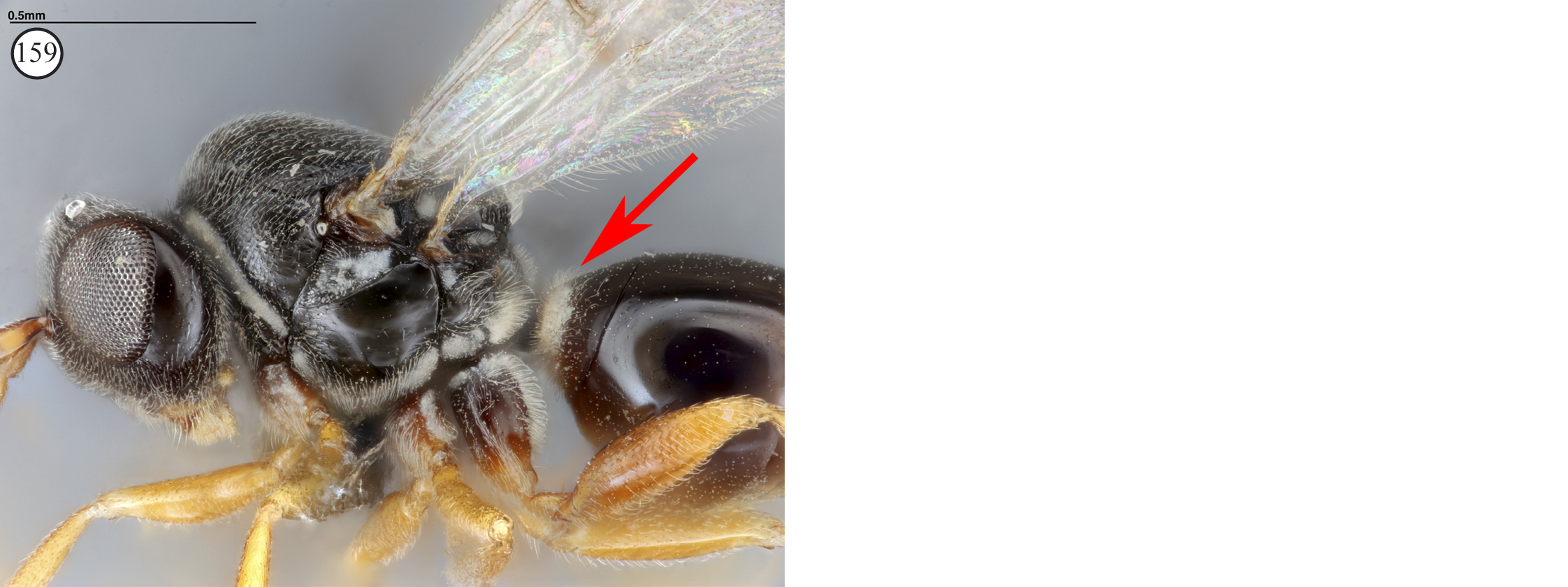
29. Short petiole, no flange or collar (arrow, Fig. 159).
Inquilines, mostly in Australia and Neotropical region, very rare in Nearctic
and East Palearctic regions. Rarely encountered ...30
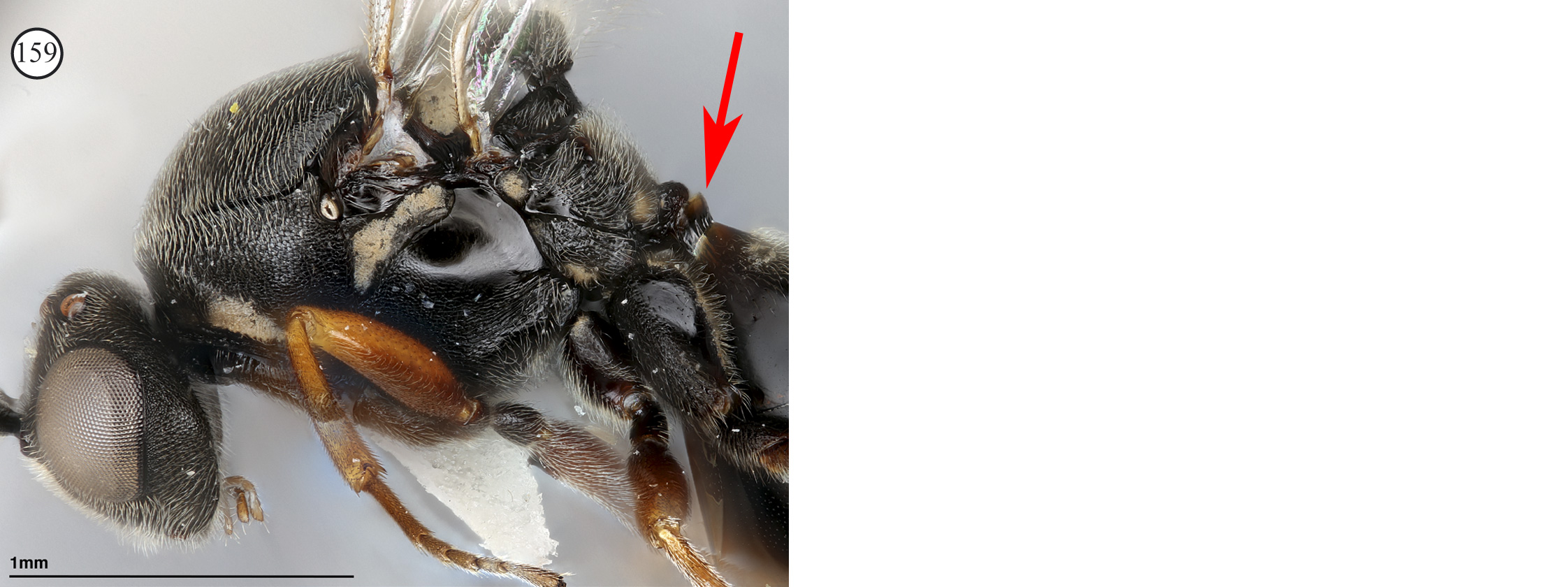
— Longer petiolar region, with a reduced basal metasomal tergite
forming a collar or sheath over petiole (arrow, Fig. 160) ...31
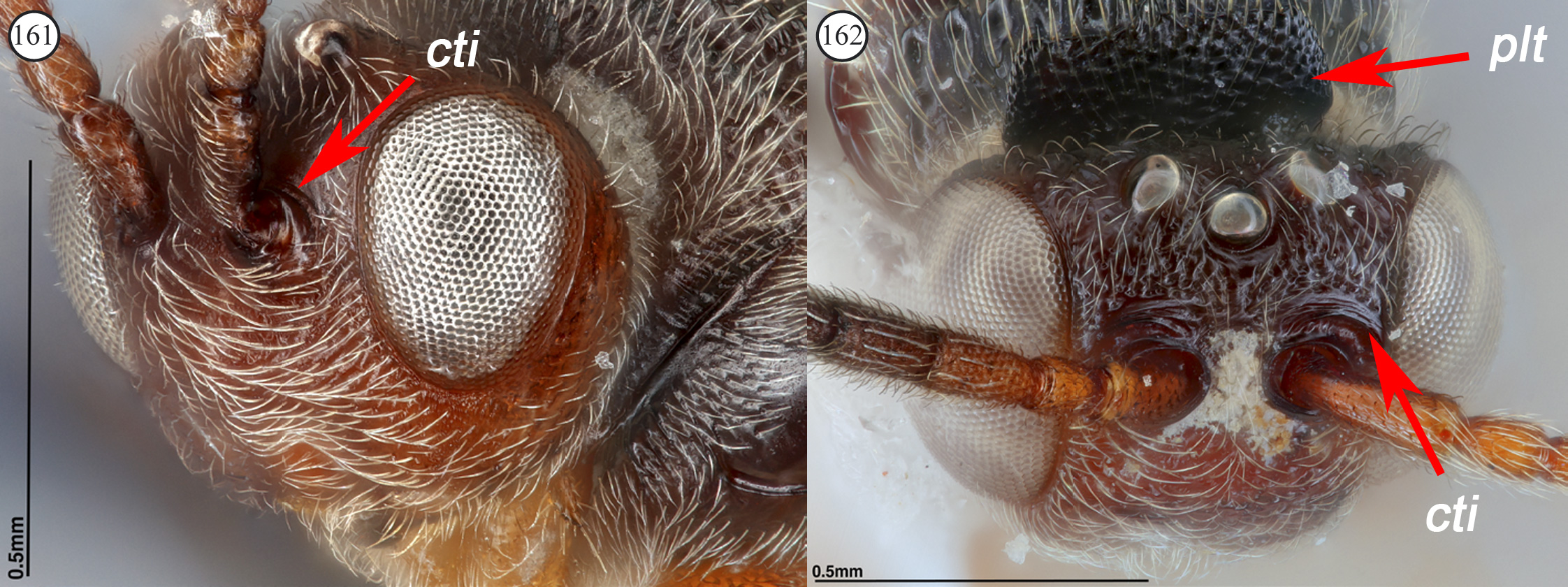
30. With a circumtorular impression (an impression above antennal
insertion) (cti, Figs 161 & 162). Often with a well-developed pronotal plate
(plt, Fig. 162) ...Thrasorinae
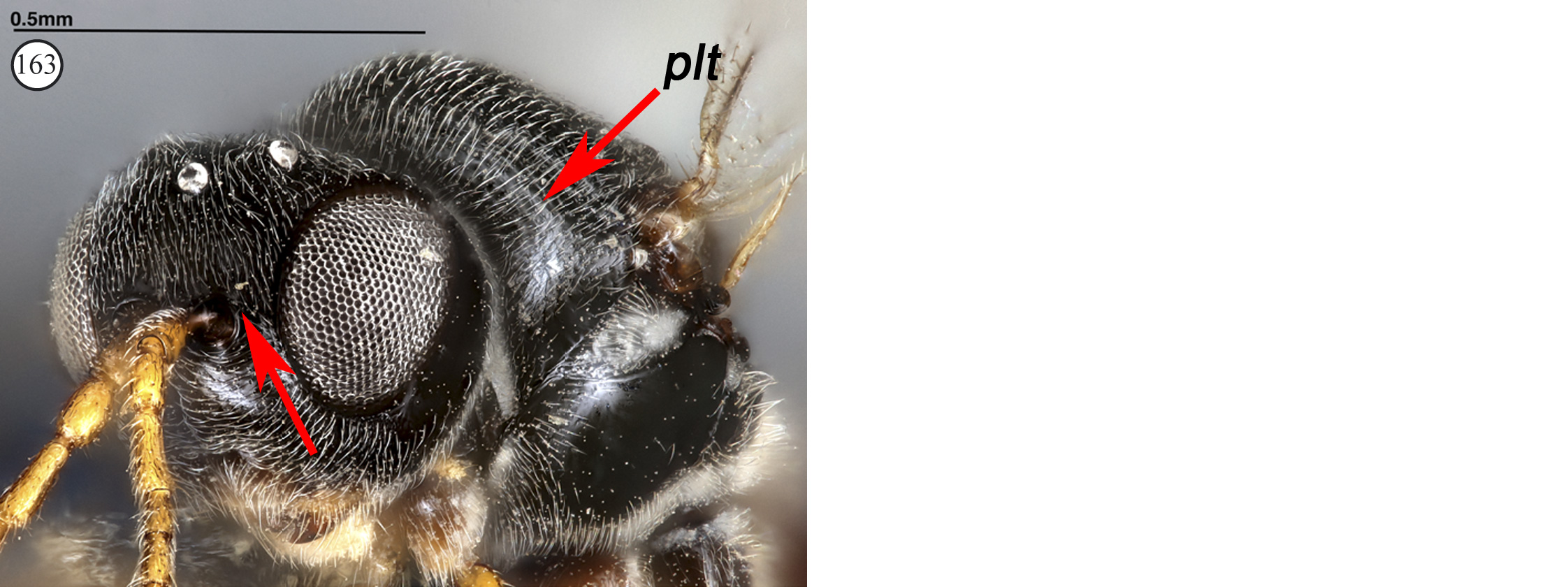
— Without a circumtorular impression (arrow, Fig. 163). Without a
well-developed pronotal plate (plt, Fig. 163). Australia only ...Mikeiinae
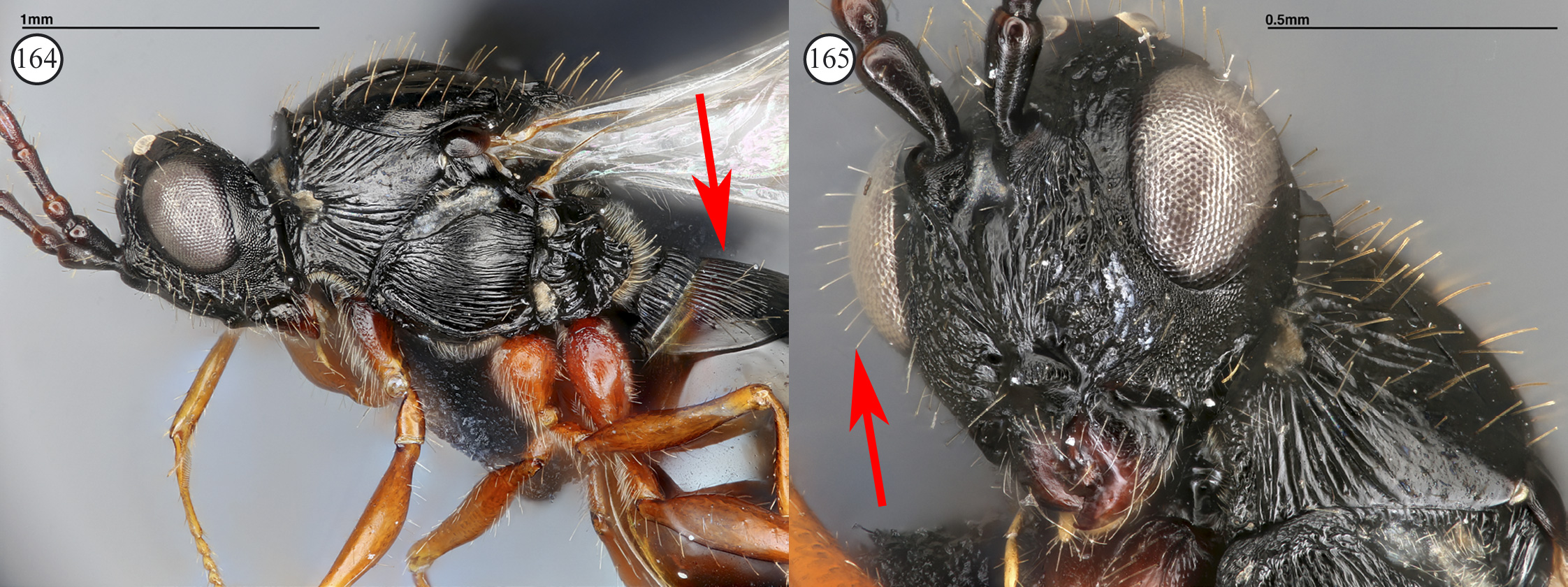
31. Without a metasomal hair patch (arrow, Fig. 164). Eyes
commonly setose (arrow, Fig 165) ...core
Figitinae
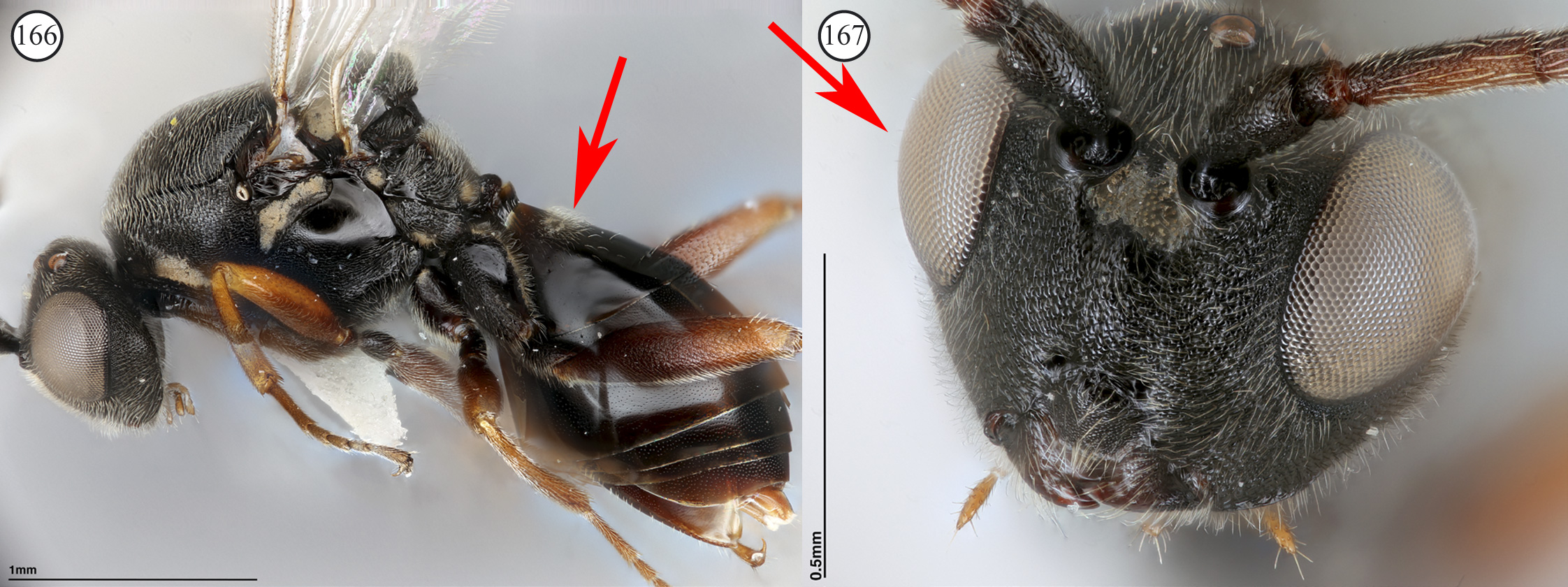
— With a metasomal hair patch (arrow, Fig 166). Eyes typically
glabrous (arrow, Fig. 167) ...32
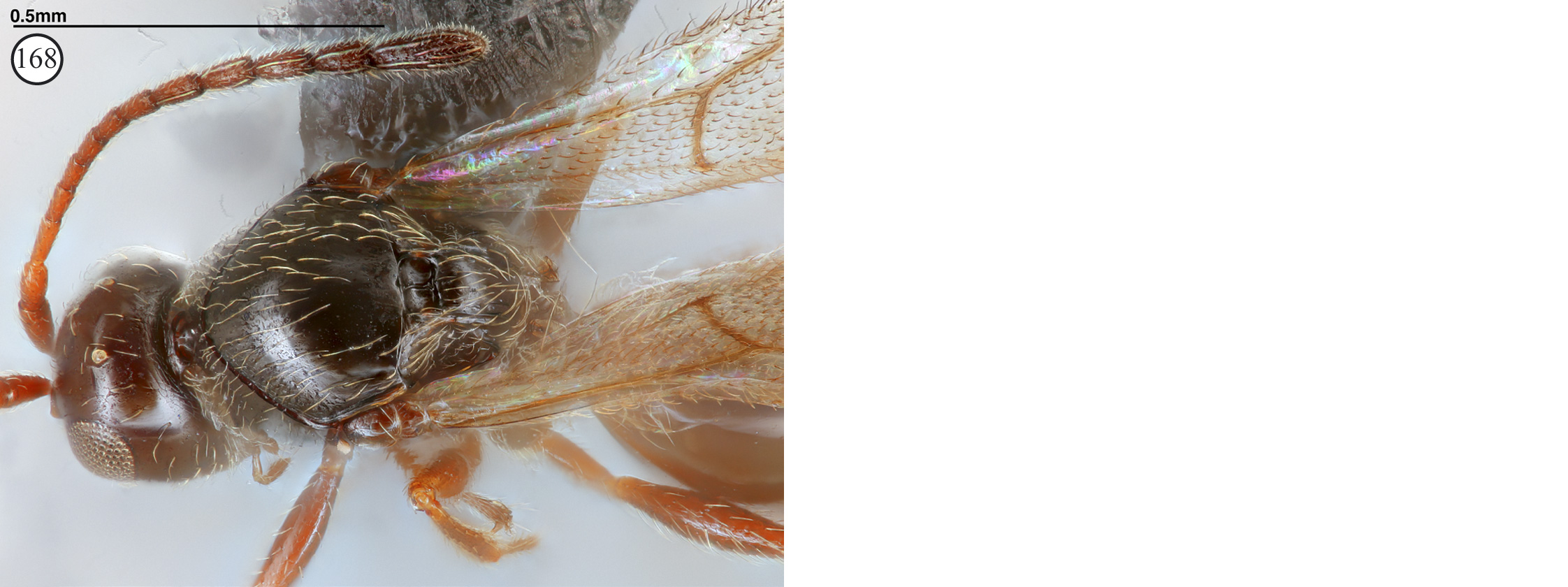
32. Mesoscutum typically shining, lacking microsculpture (Fig.
168), frequently with long setae present ...several
Figitinae
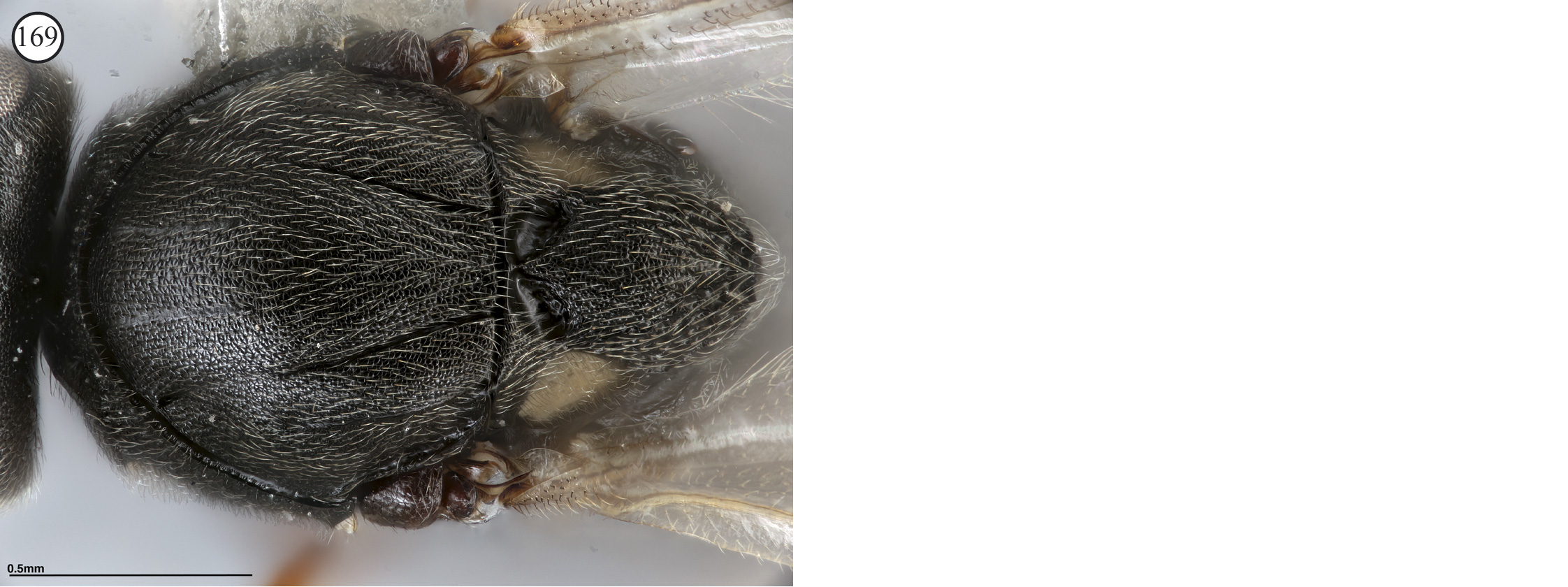
— Mesoscutum matte and leathery with dense microsculpture (Fig.
169) ...Melanips (Aspicerinae)
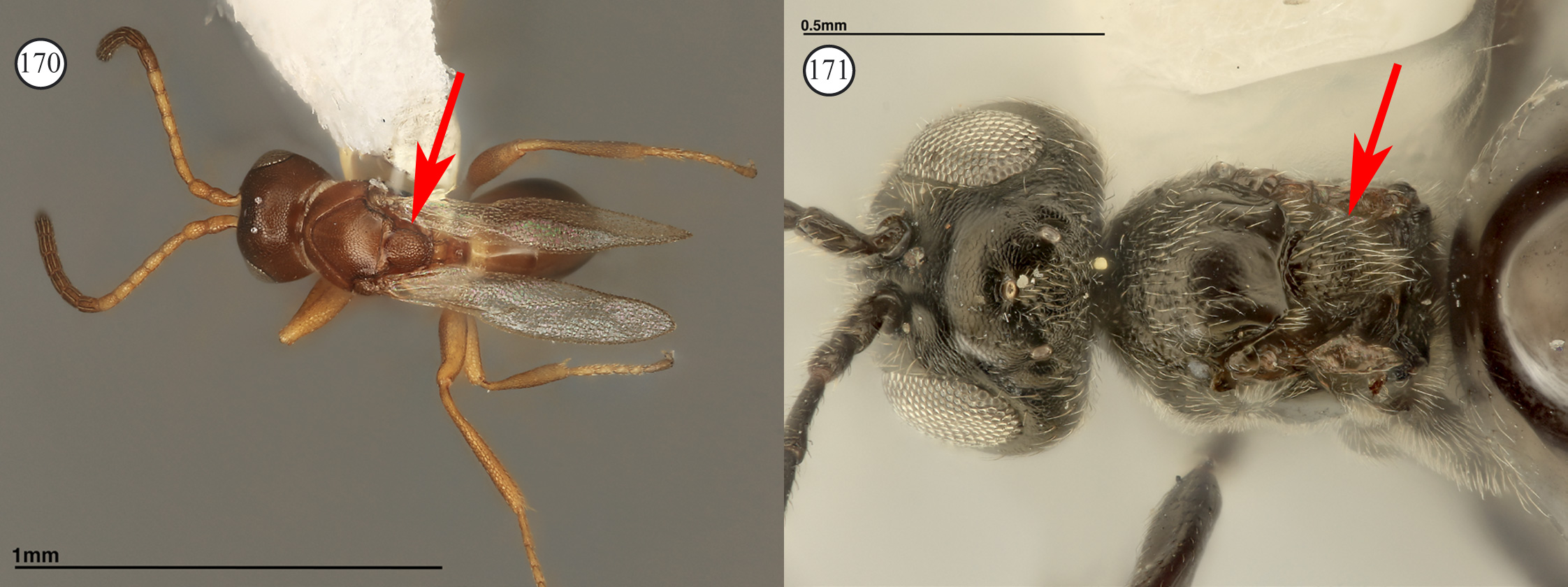
33. Scutellum simple, without a distinct scutellar plate (arrows,
Figs 170 & 171) ...34
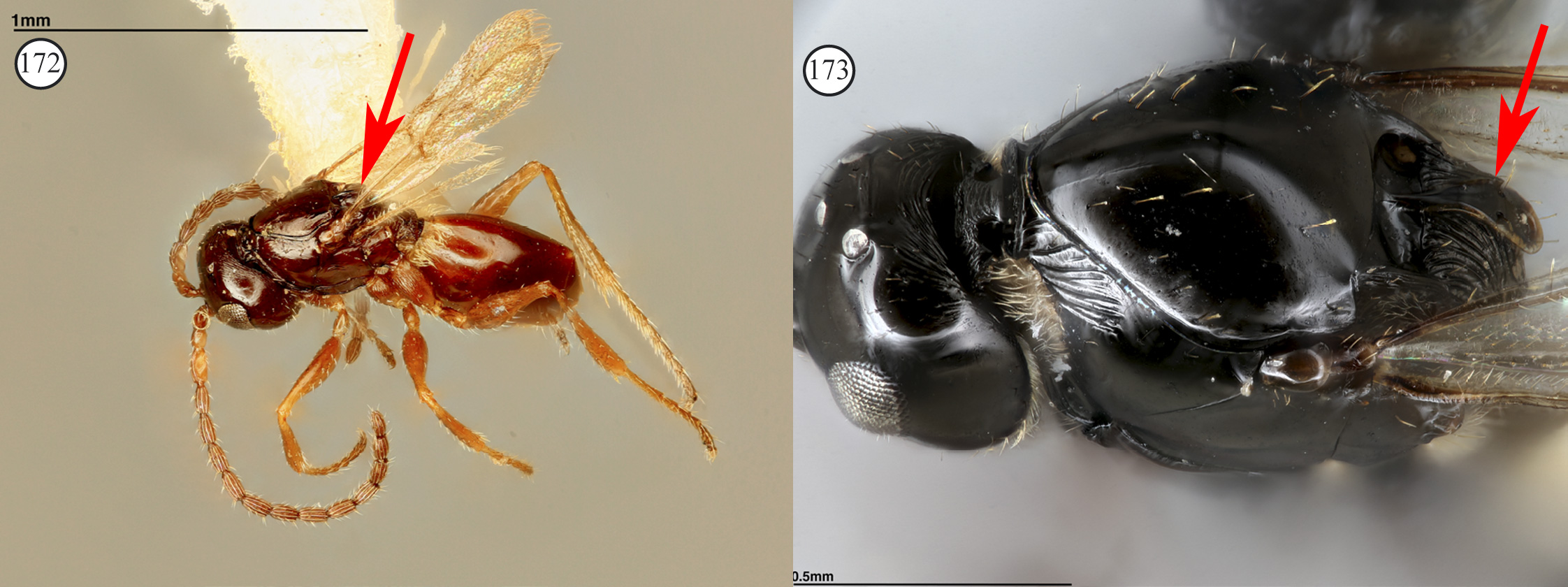
— Scutellum surmounted by distinct scutellar plate (arrows, Figs
172-173) ...Eucoilinae
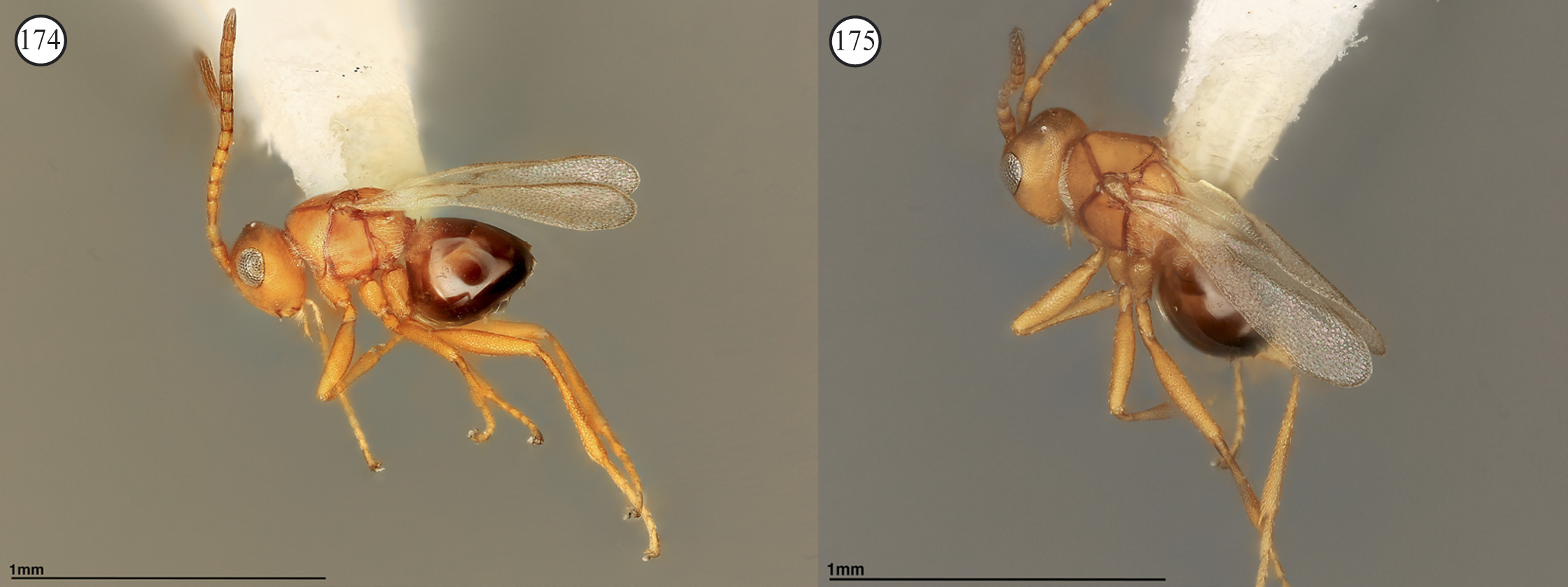
34. Metasoma about the size of the mesosoma (Figs 174 & 175);
brachyptery (Figs 174 & 175) more common than aptery. Colour variable but very
often pale. Mesosoma usually not strikingly narrow. Scutellum evenly convex.
Mainly in summer in the Holarctic Region ...Charipinae
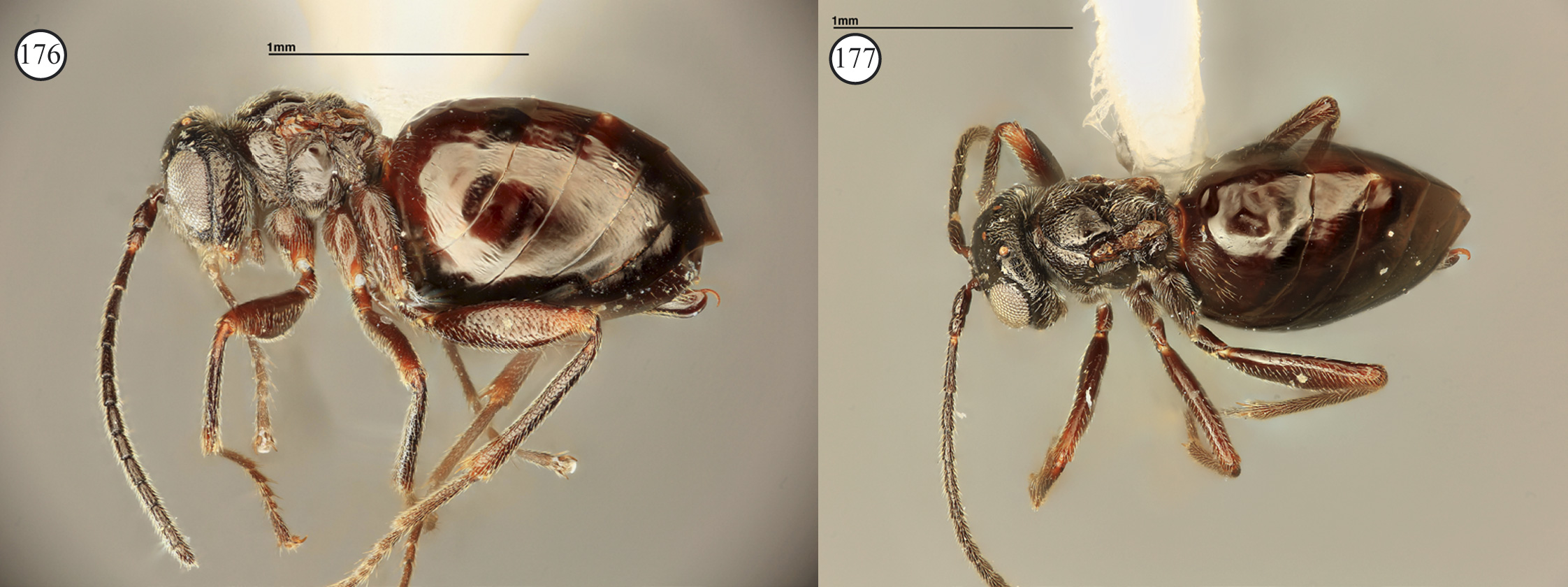
— Metasoma at least twice the size of mesosoma (Figs. 176 & 177);
apterous (Figs. 176 & 177) to brachypterous. Colour variable but often dark.
Mesosoma usually strikingly narrow. Scutellum rather flat. Mainly in the winter
half of the year the Holarctic Region ...Cynipini (alternate generation of
winged forms)
|